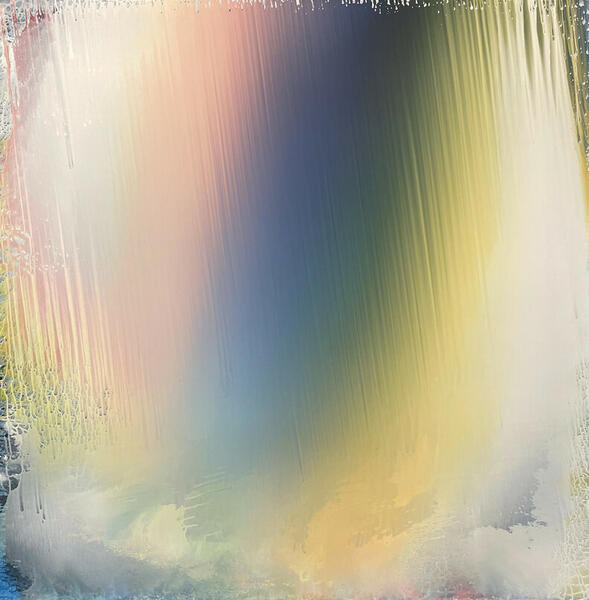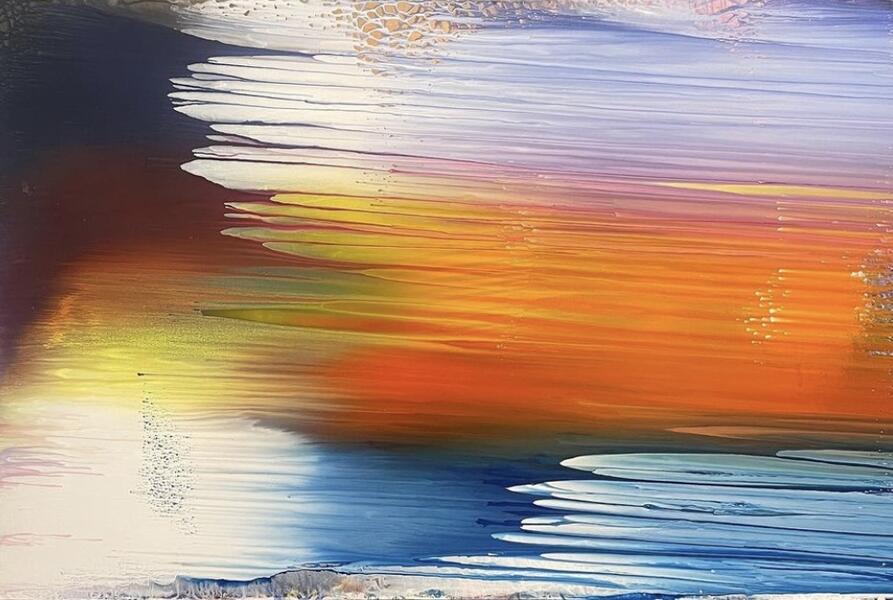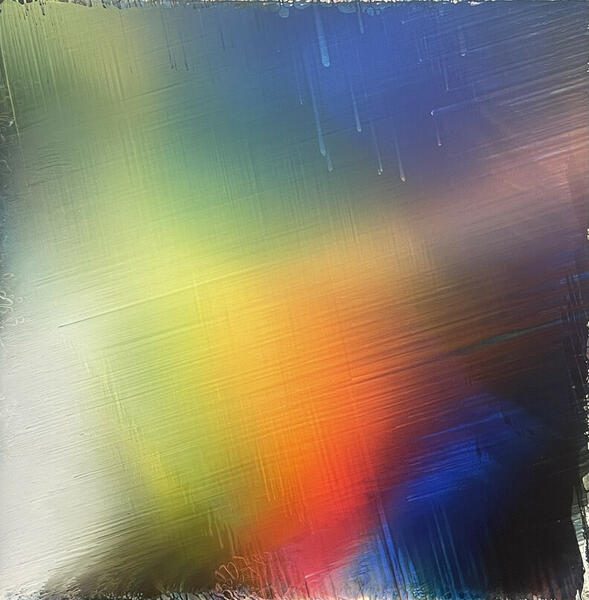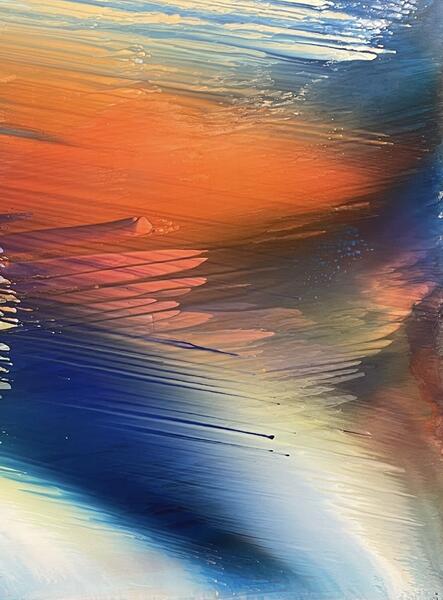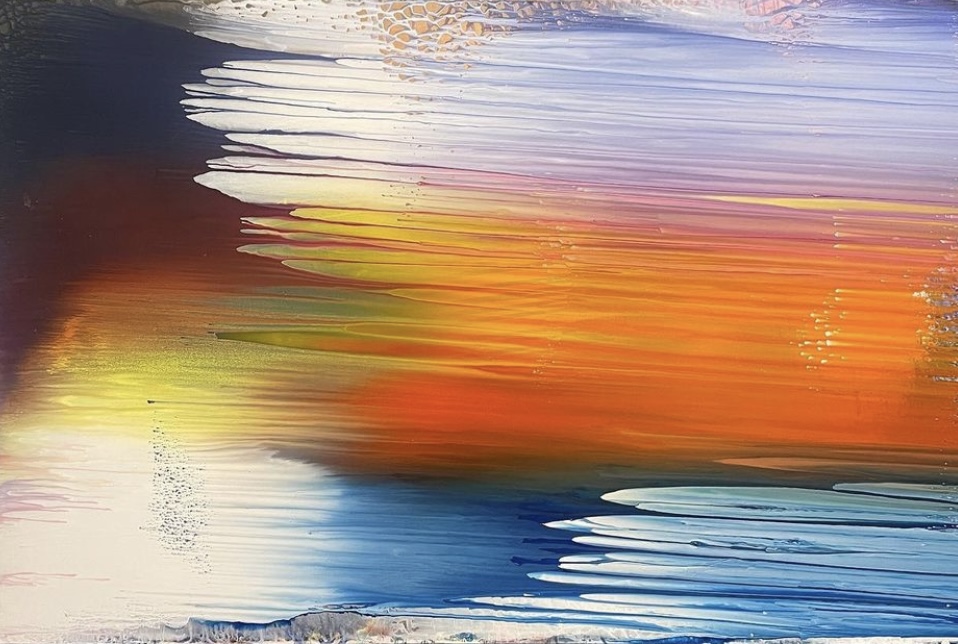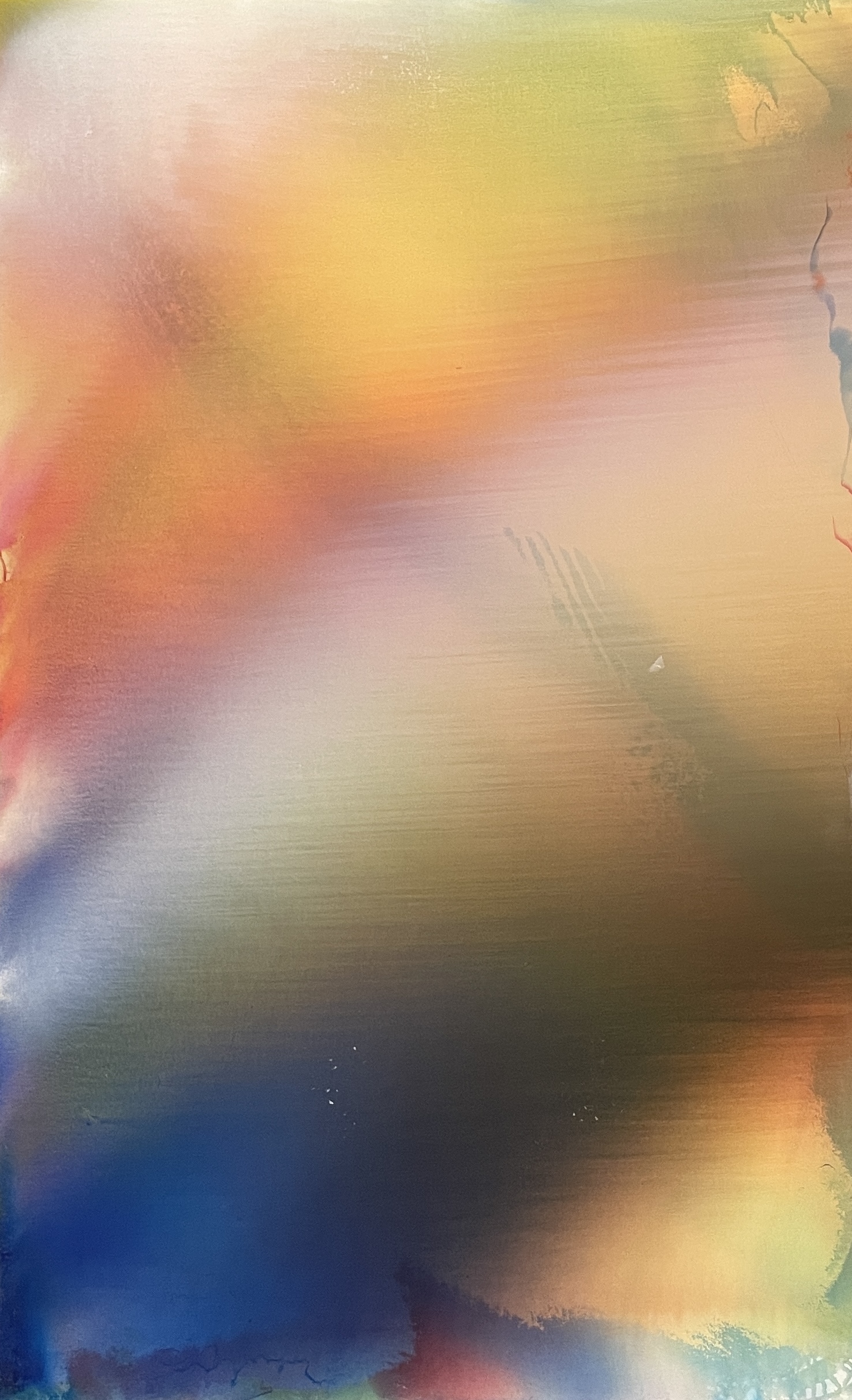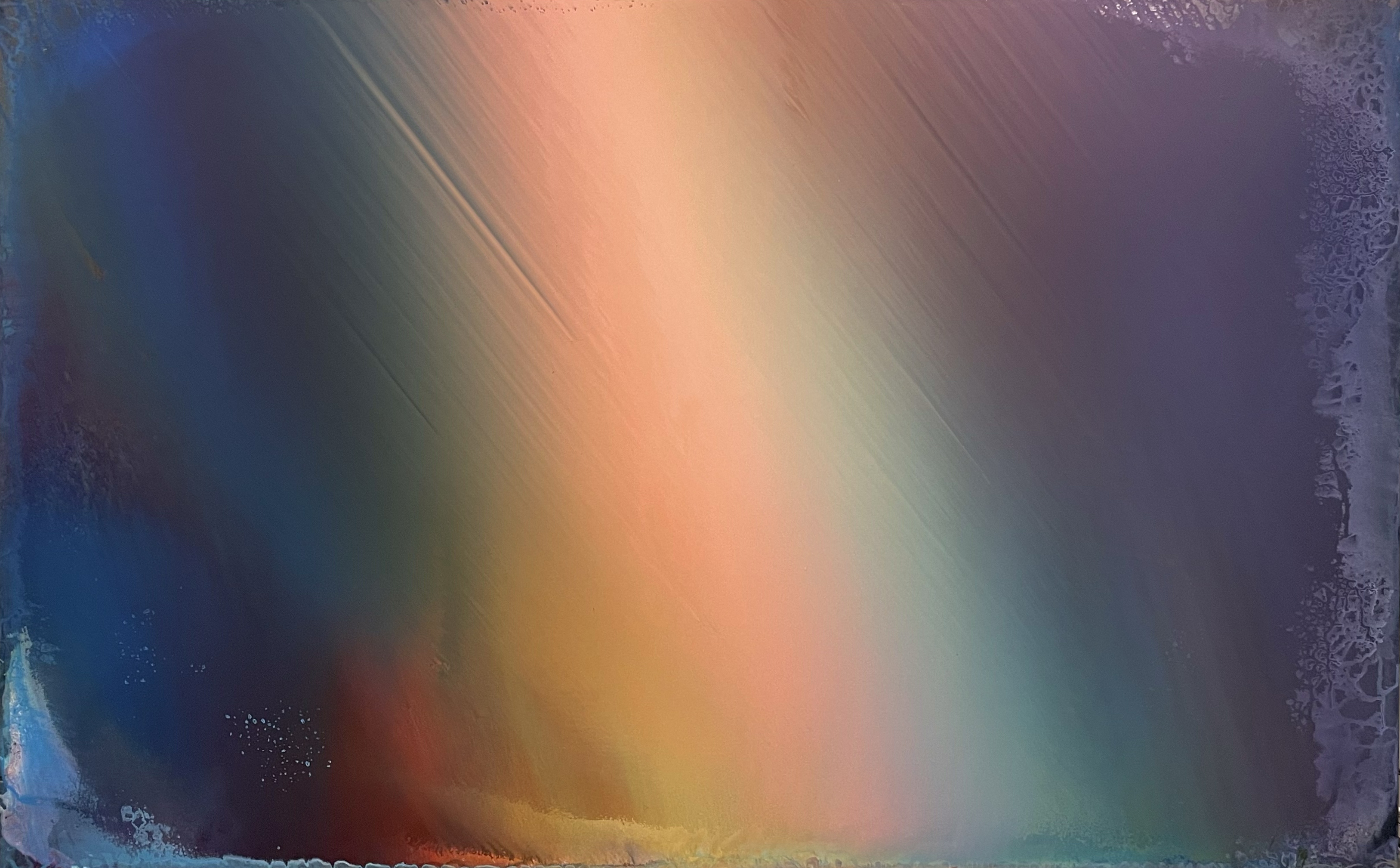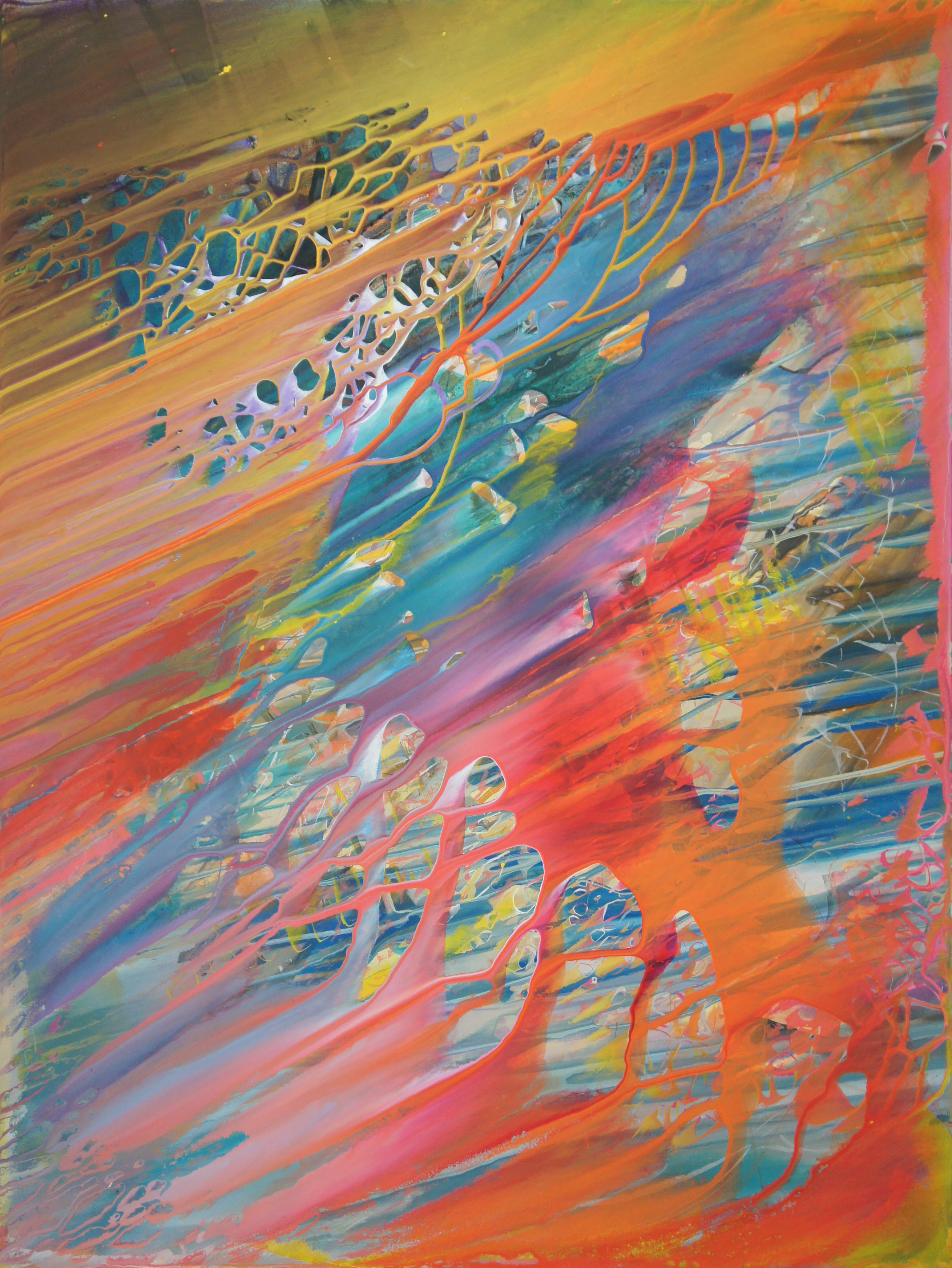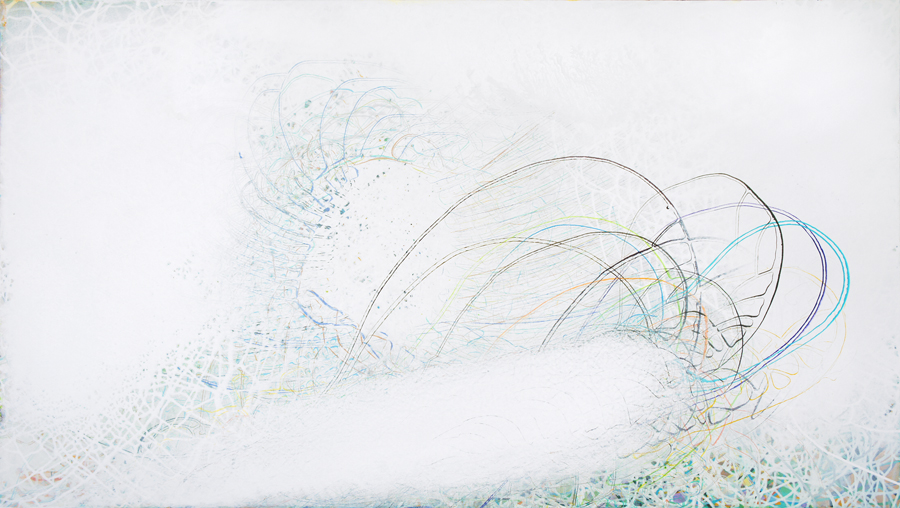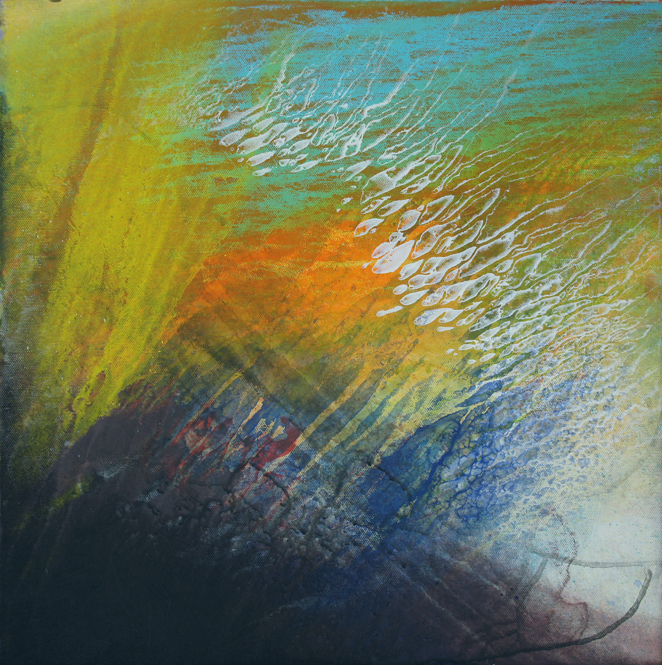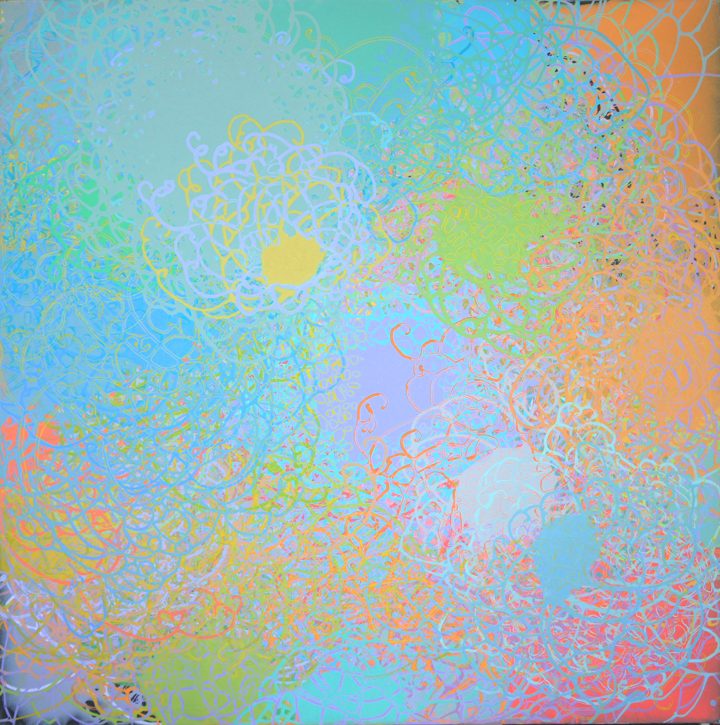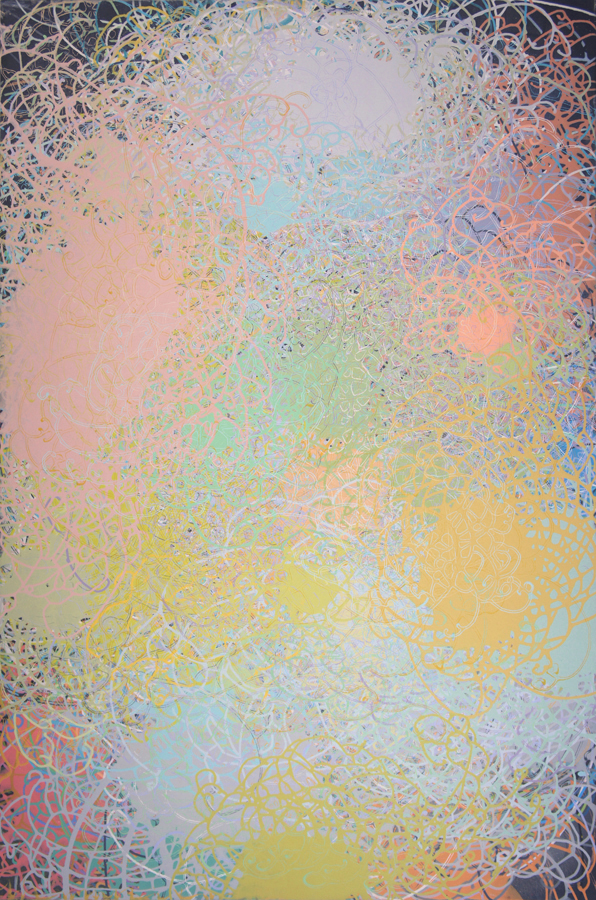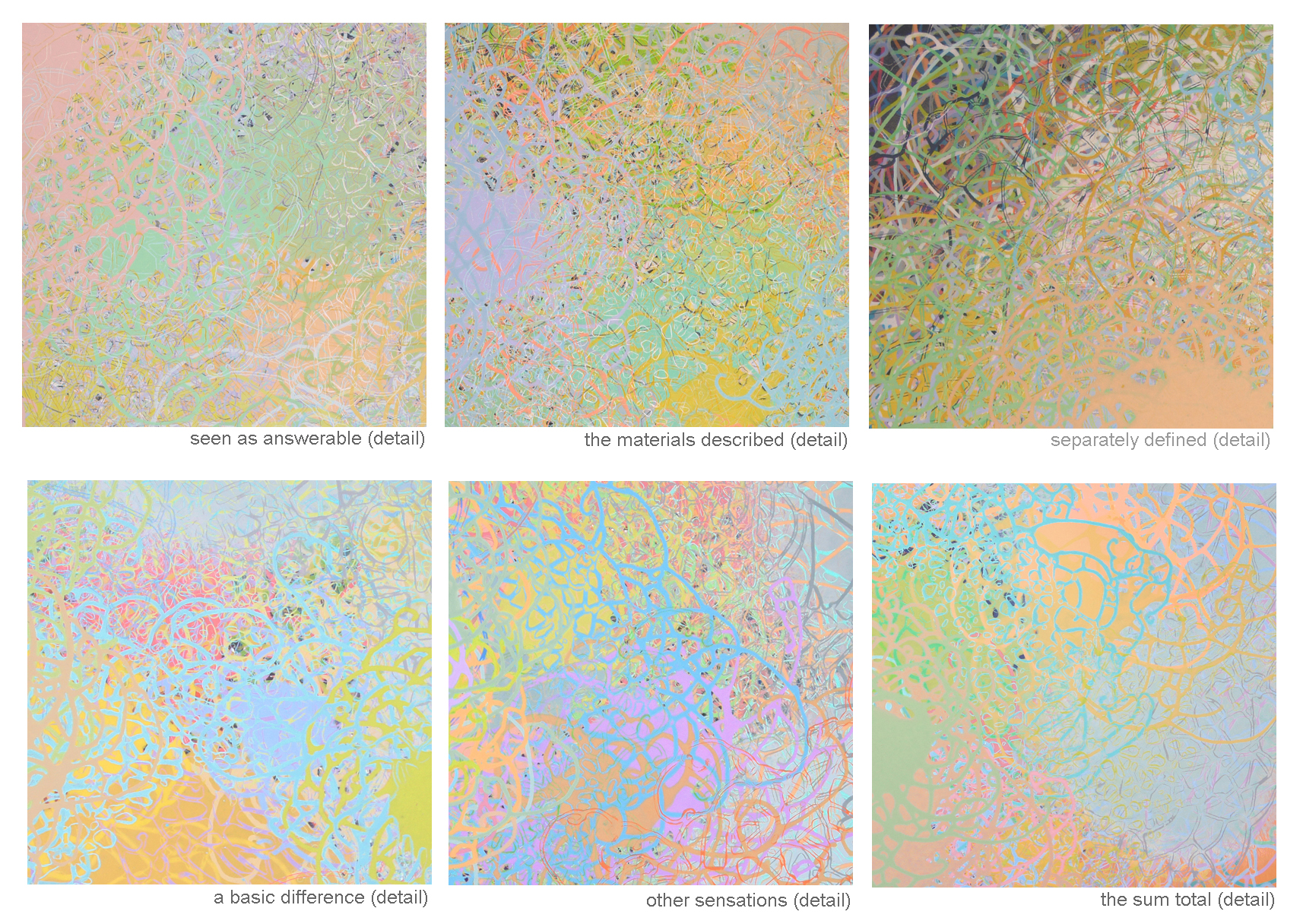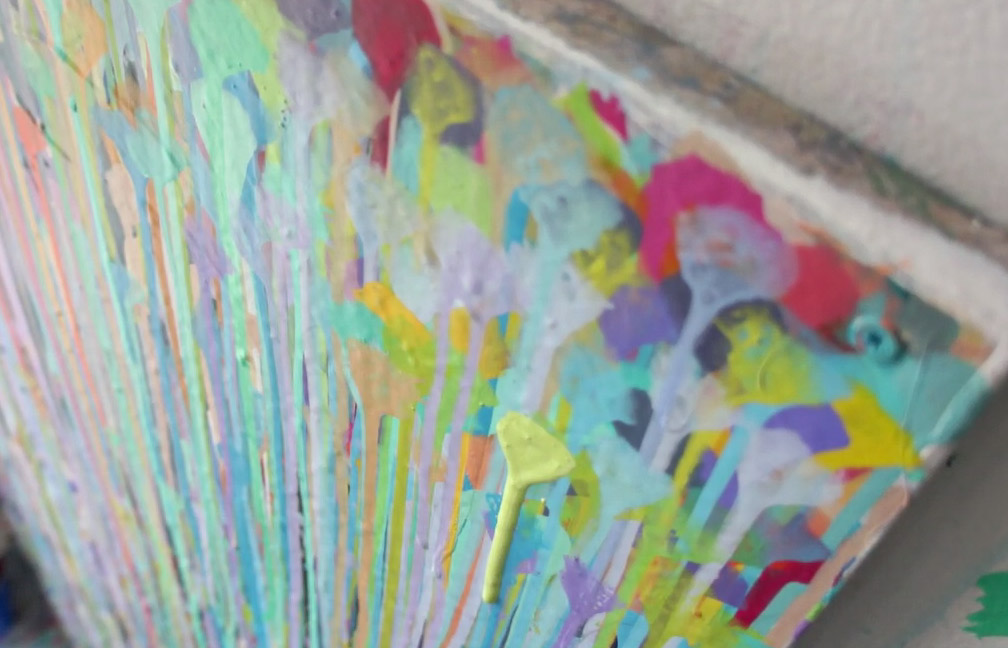Work samples
About Greg
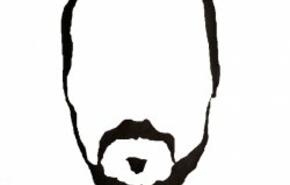
STATEMENT
Water ghostwrites my painting. It erodes and transplants; it pools and it dries away. It conspires with pigment and ground to carve and compose stories stacked with resonant harmonies. I’m a participant in these pieces, pivoting with the unpredictable nature of fluid paint, gazing at the material flux.
BIO
Greg Minah grew up in Columbia, Maryland and graduated from the University of Maryland at… more
Selected Paintings, 2022-2023
My studio practice has shifted in the last couple years due to my need to split time between a full-time job and my painting. This has led to much more focused and concentrated studio work sessions. Also, I've noticed that having more time between sessions has led to the work more freely leaning in multiple directions at once. With more time in the studio my work could very slowly ebb and flow. But with more intermittent time, the work seems to be punctuated with much more variety and nuance. I was worried that less time would mean a weakening relationship to my work but I feel just the opposite has happened: I've learned to trust my practice more, that it's not something fleeting and tenuous but something that I carry with me and something that carries me.
-
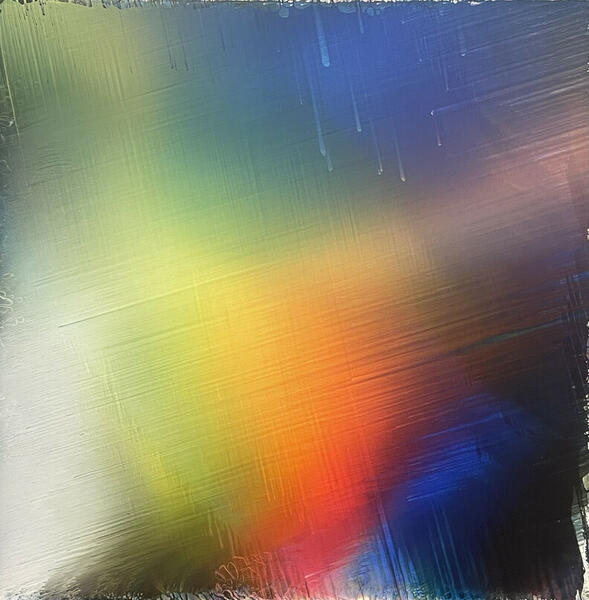 reflect as reality 54 by 54 inches acrylic on canvas 2022
reflect as reality 54 by 54 inches acrylic on canvas 2022reflect as reality 54 by 54 inches acrylic on canvas 2022
-
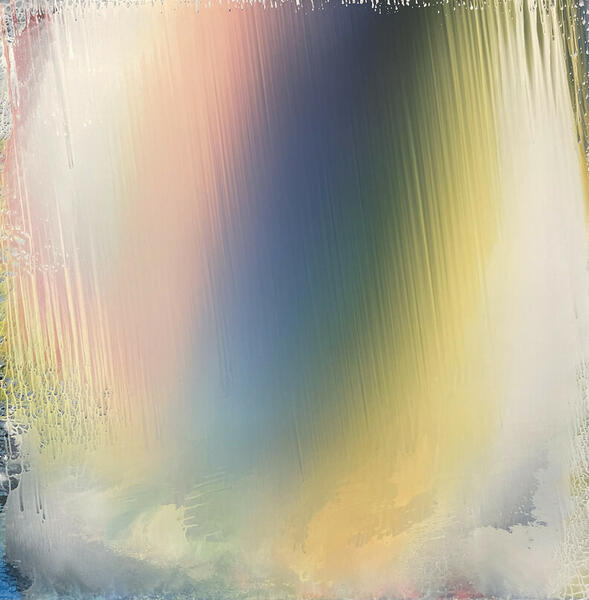 our theory 2022 acrylic on canvas 54 by 54 inches
our theory 2022 acrylic on canvas 54 by 54 inchesour theory 2022 acrylic on canvas 54 by 54 inches
-
 unexpressed elements 2023 40 by 60 inches acrylic on canvas
unexpressed elements 2023 40 by 60 inches acrylic on canvasunexpressed elements 2023 40 by 60 inches acrylic on canvas
-
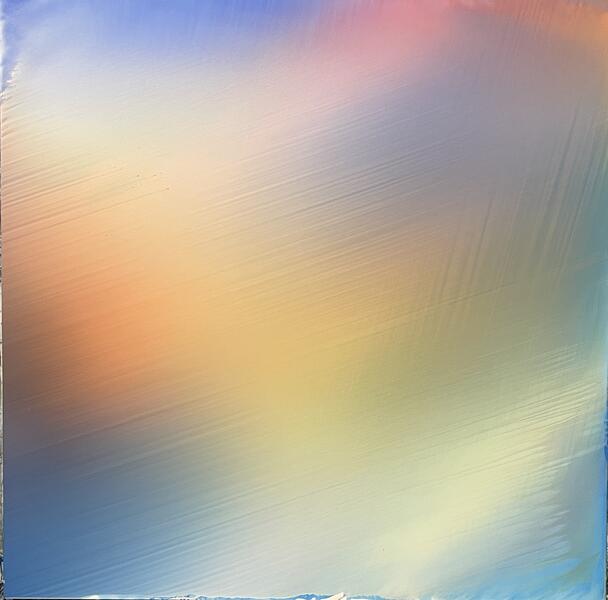 this new unity 60 by 60 inches acrylic on canvas 2023
this new unity 60 by 60 inches acrylic on canvas 2023this new unity 60 by 60 inches acrylic on canvas 2023
-
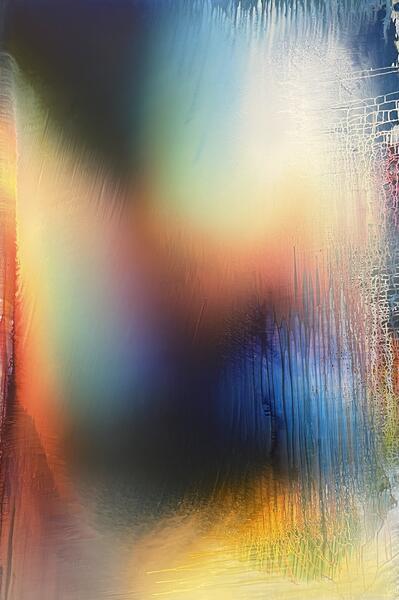 certain phases 60 by 40 inches acrylic on canvas 2023
certain phases 60 by 40 inches acrylic on canvas 2023certain phases 60 by 40 inches acrylic on canvas 2023
-
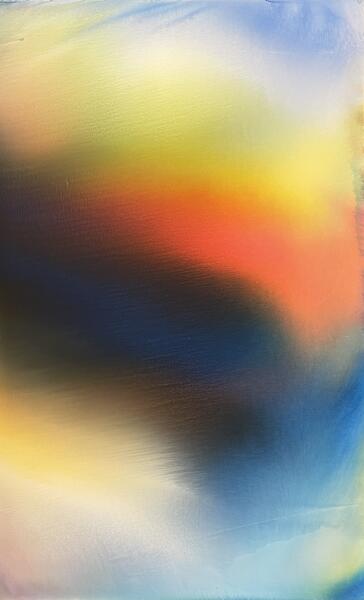 the constant rearrangement 54 by 34 inches acrylic on canvas 2022
the constant rearrangement 54 by 34 inches acrylic on canvas 2022the constant rearrangement 54 by 34 inches acrylic on canvas 2022
-
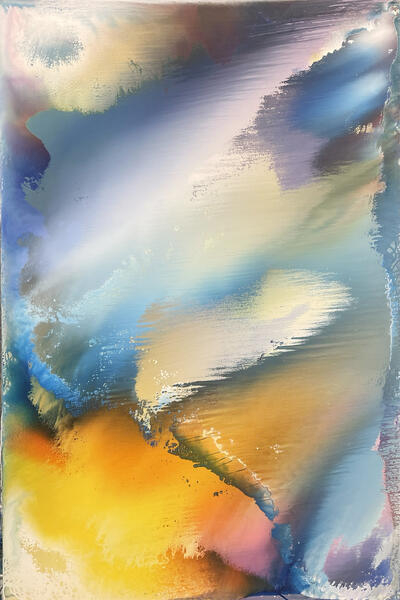 from this time on 60 by 40 acrylic on canvas 2022
from this time on 60 by 40 acrylic on canvas 2022from this time on 60 by 40 acrylic on canvas 2022
-
 similarly sounding words 54 by 34 inches acrylic on canvas 2023
similarly sounding words 54 by 34 inches acrylic on canvas 2023similarly sounding words 54 by 34 inches acrylic on canvas 2023
-
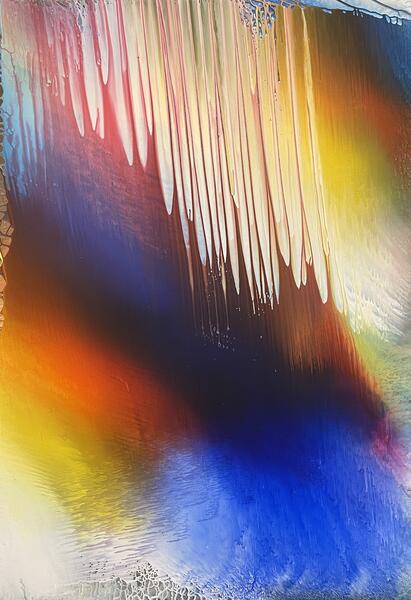 of this drive 54 by 34 inches acrylic on canvas 2023
of this drive 54 by 34 inches acrylic on canvas 2023of this drive 54 by 34 inches acrylic on canvas 2023
-
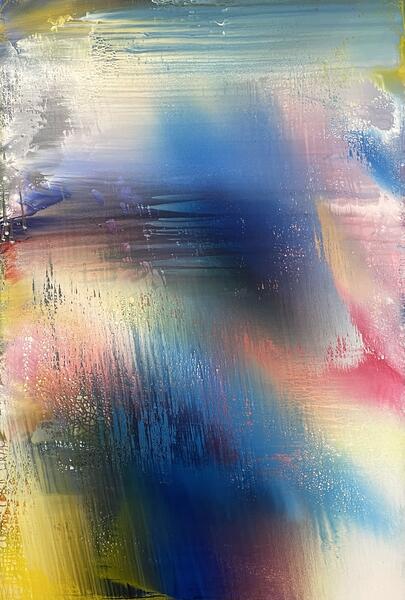 in its passion 72 by 48 acrylic on canvas 2023
in its passion 72 by 48 acrylic on canvas 2023in its passion 72 by 48 acrylic on canvas 2023
Selected Paintings, 2020-2021
The multi-layered construction that resulted from the techniques I developed in 2018-2019 began to open up into portals, of sorts, in 2020. These windows offered a glimpse into something new, as this process-based method of painting continually does over time. If the earlier works from 2020 depicted these portals, then the later works seem to depict what lay within and beyond the passageways.
In 2021, despite a marked drop in sales and opportunities for exposure, I did my best to stay in motion in the studio. The resulting paintings presented in this project seem to have lightened up a bit. The dominant black tones that steered the compositions from 2020 have been replaced with whiter and brighter notes. It’s been a challenging year for many in art-related fields and I’ve really clung to my studio practice as a way to get through the various personal and professional challenges of 2021.
-
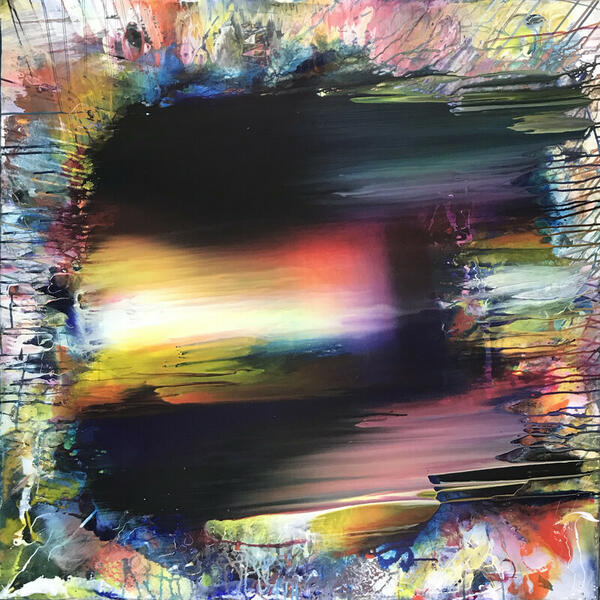 "the real powers" 42 by 42 inches acrylic on canvas 2020
"the real powers" 42 by 42 inches acrylic on canvas 2020"the real powers" 42 by 42 inches acrylic on canvas 2020
-
 over those elements 54 by 34 inches acrylic on canvas 2020
over those elements 54 by 34 inches acrylic on canvas 2020over those elements 54 by 34 inches acrylic on canvas 2020
-
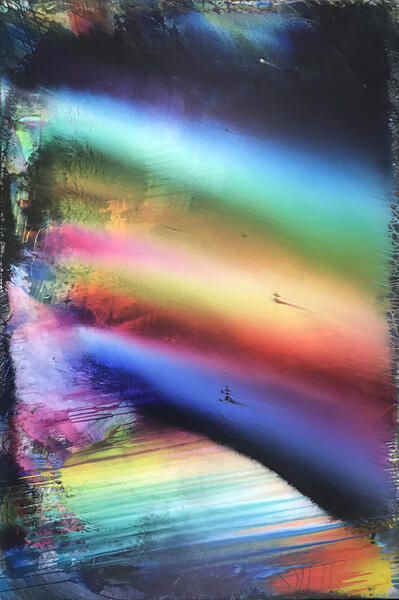 simply a convention 72 by 48 inches acrylic on canvas 2020
simply a convention 72 by 48 inches acrylic on canvas 2020simply a convention 72 by 48 inches acrylic on canvas 2020
-
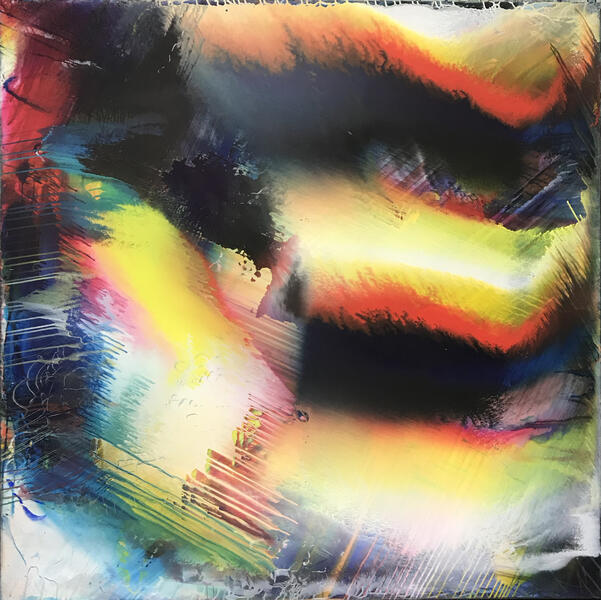 order to convey 60 by 60 inches acrylic on canvas 2020
order to convey 60 by 60 inches acrylic on canvas 2020order to convey 60 by 60 inches acrylic on canvas 2020
-
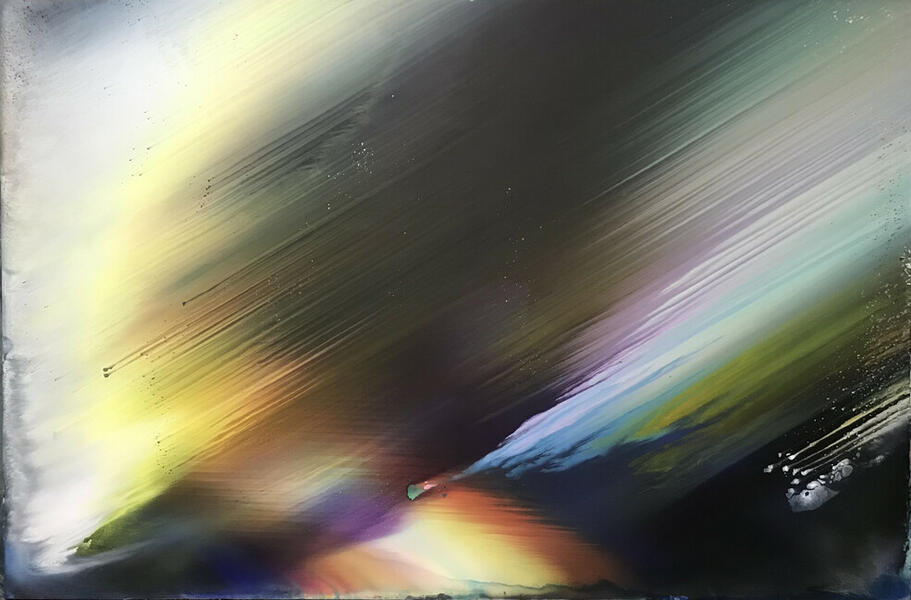 also a synthesis 48 by 72 inches acrylic on canvas 2020
also a synthesis 48 by 72 inches acrylic on canvas 2020also a synthesis 48 by 72 inches acrylic on canvas 2020
-
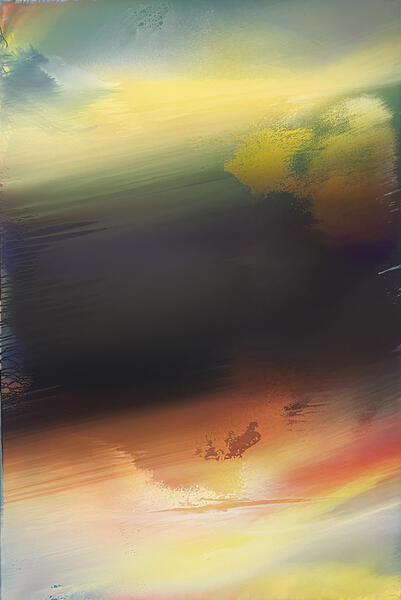 we know the appearance.jpgwe know the appearance 2021 acrylic on canvas 60 by 40 inches
we know the appearance.jpgwe know the appearance 2021 acrylic on canvas 60 by 40 inches -
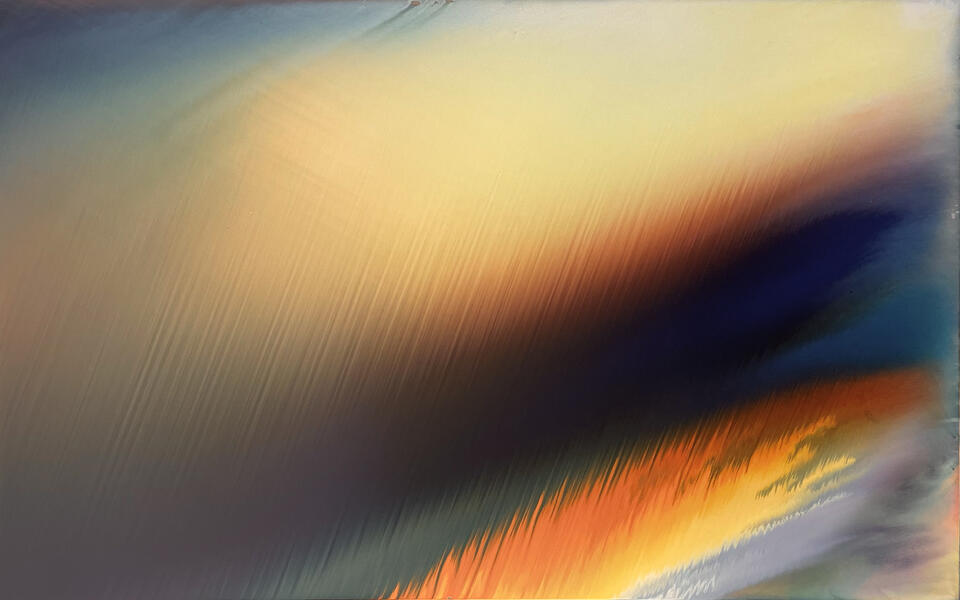 the other differences.jpgthe other differences 2021 acrylic on canvas 34 by 54 inches
the other differences.jpgthe other differences 2021 acrylic on canvas 34 by 54 inches -
 reaffirm the reality.jpgreaffirm the reality 2021 acrylic on canvas 34 by 54 inches
reaffirm the reality.jpgreaffirm the reality 2021 acrylic on canvas 34 by 54 inches -
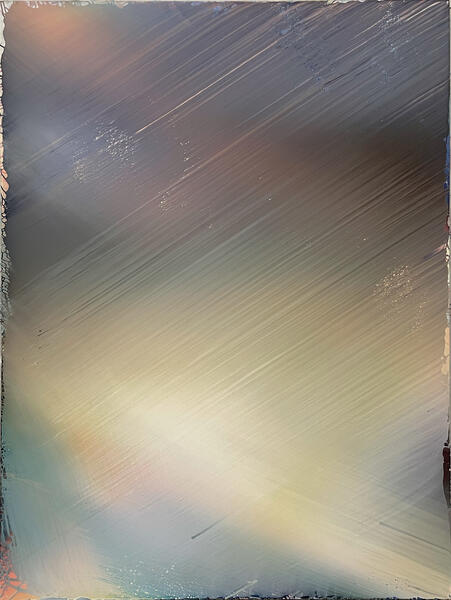 remote association.jpgremote association 2021 acrylic on canvas 72 by 54 inches
remote association.jpgremote association 2021 acrylic on canvas 72 by 54 inches -
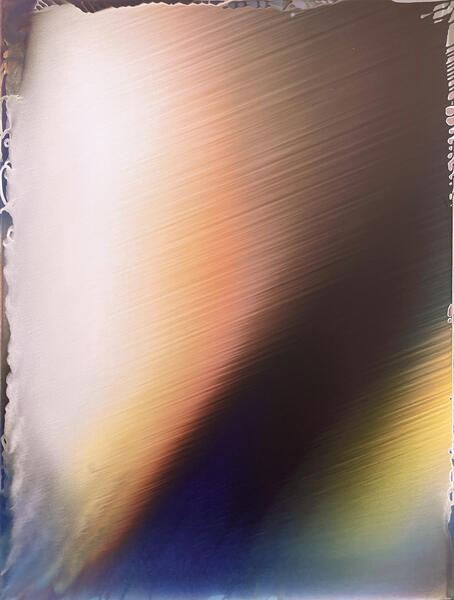 a certain situation.jpga certain situation 2021 acrylic on canvas 40 by 30 inches
a certain situation.jpga certain situation 2021 acrylic on canvas 40 by 30 inches
Selected Paintings, 2018-2019
2018 was a landmark year for me as it marked 10 years since I became a full-time artist. In 2008 I completed an artist residency in Joshua Tree, California that had a profound and lasting effect on me and my work. While in the desert 10 years ago, I first began to experiment with pouring paint and moving the stretcher to control its flow. This method of painting came to define my style and has been well documented in essays, interviews, and videos over the years (see 'Painting Process, 2011' project in this nomination to watch a short video).
In 2019, my painting process was really guided by a rigorous devotion to working in the studio. My most recent work seems to be drawing on the myriad techniques and processes I’ve developed over the years. I’ve consciously tried to abandon the idea that my work needs to adhere to some imagined narrative, whether stylistically or historically. The individual paintings presented in this project are more unique expressions unto themselves. As my methods continue to evolve and complexify, the paintings reflect this. Some of these have taken me much longer to resolve. Others seem to get to this place more quickly. I’ve been striving to recognize and trust this moment regardless of whether it comes after weeks and months of struggle or after one lucky pour. Trusting this process has been a focussed effort in 2019.
-
to an ensemble"to an ensemble" acrylic on canvas 40 by 30 inches 2018
-
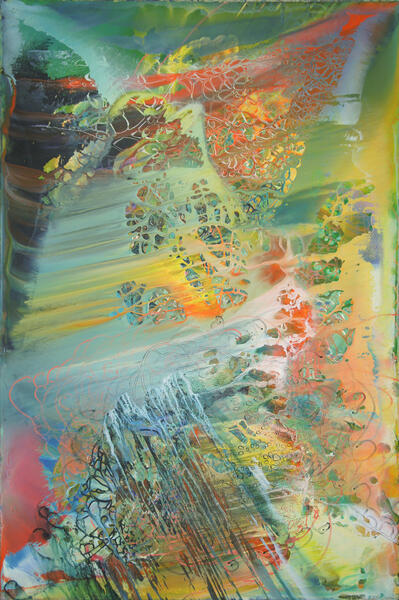 regarding sensation"regarding sensation" acrylic on canvas 72 by 48 inches 2018
regarding sensation"regarding sensation" acrylic on canvas 72 by 48 inches 2018 -
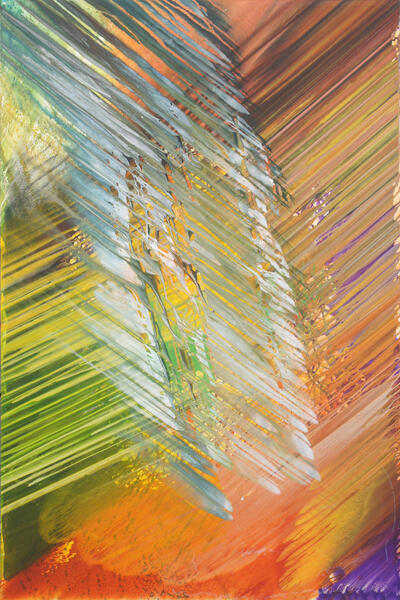 the same tradition"the same tradition" acrylic on canvas 63.5 by 42 inches 2018
the same tradition"the same tradition" acrylic on canvas 63.5 by 42 inches 2018 -
must so interact"must so interact" acrylic on canvas 60 by 40 inches 2018
-
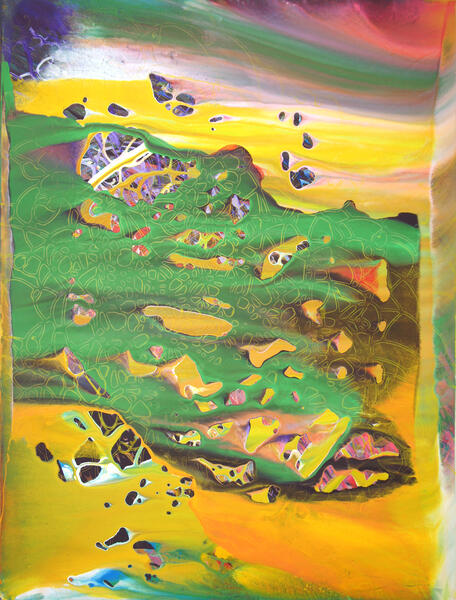 a definite duality"a definite duality" acrylic on canvas 40 by 30 inches 2018
a definite duality"a definite duality" acrylic on canvas 40 by 30 inches 2018 -
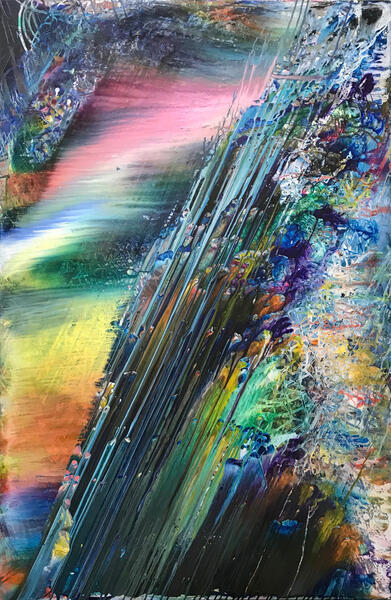 IMG_5189.jpg
IMG_5189.jpg -
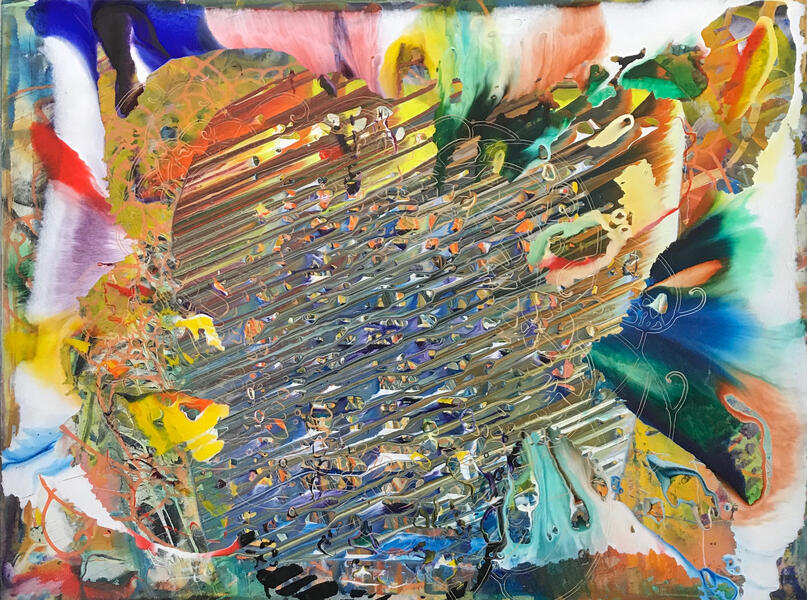 part of a process.jpg
part of a process.jpg -
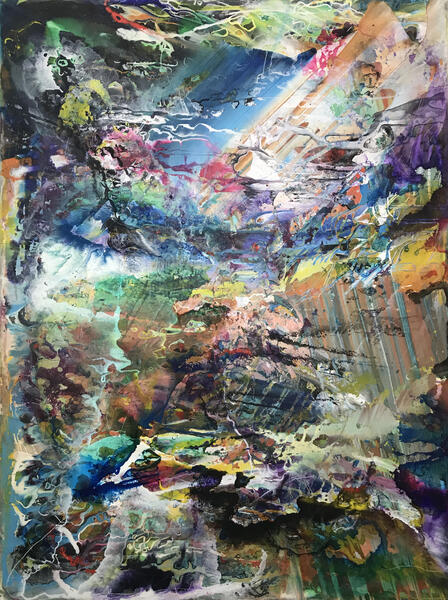 this notion appeared"this notional appeared" 40 by 30 inches acrylic on canvas 2019
this notion appeared"this notional appeared" 40 by 30 inches acrylic on canvas 2019 -
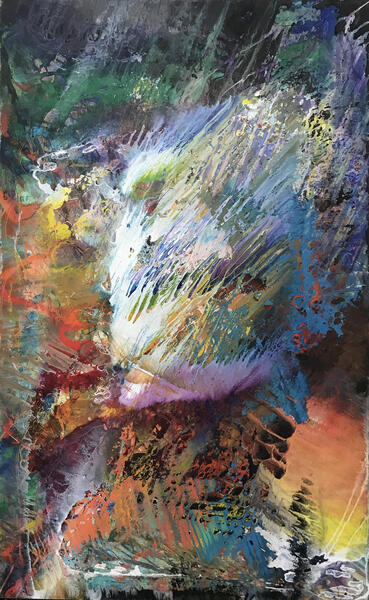 all the variations-small"all the variations" 54 by 34 inches acrylic on canvas 2019
all the variations-small"all the variations" 54 by 34 inches acrylic on canvas 2019 -
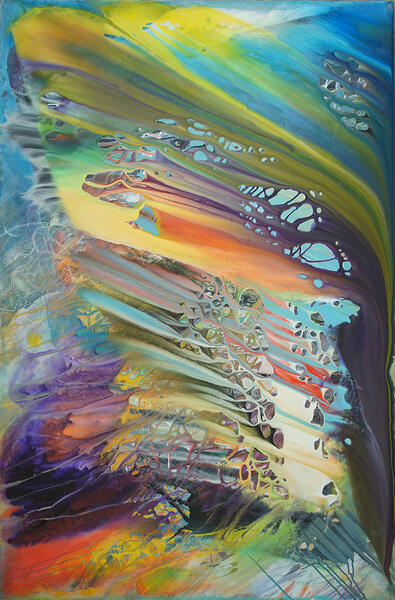 within sensuality.jpg"within sensuality" 60 by 40 inches acrylic on canvas 2019
within sensuality.jpg"within sensuality" 60 by 40 inches acrylic on canvas 2019
Painting Process, 2017-2019
I hope these videos allow the viewer a deeper connection to how these paintings were made and why this process-oriented method of making them is so important to me. These videos are becoming more and more an artform on their own, too.
-
Greg Minah: Painting | FlowDuring my recent artist residency in Joshua Tree, California, I noticed that the overflow from my painting process was creating some beautiful moments as the medium moved and flowed. For more information, please visit www.gregminah.com
-
Process ClipsA compilation of some short clips of my most recent painting method. I share videos and like these and detail shots of works in progress on my Instagram page: www.instagram.com/gminah
-
Detail 1Detail 1
-
Detail 2Detail 2
-
Detail 3Detail 3
-
Detail 4Detail 4
-
Detail 5Detail 5
-
Detail 7Detail 7
-
Detail 8Detail 8
-
Detail 9Detail 9
Selected Paintings, 2016-2017
2017 was a year marked by change. I moved studios for the first time since 2005, or so, and the work seems to have gone in a new direction, as well. The small works on panel from 2016 clearly paved the way for these larger works on canvas. Here, as in 2016, I allow the medium to move more slowly across the surface for extended periods of time. As a result, the more turbulent areas are unified by these long, drawn-out pathways--a kind of harmonic stability. The larger format of these paintings showcase this technique in a way that was hard to achieve on the smaller panel pieces.
While my painting methods in 2017 still employ much of the same techniques as documented in the 'Process' project of this nomination (below) there are new tricks and devices I'm using that allow for the presence of the unpredictable---something that adds a certain authenticity and naturalness to the work, I think. The paintings presented in this project are what inspired me to revise my artist statement this year:
Water ghostwrites my painting. It erodes and transplants; it pools and it dries away. It conspires with pigment and ground to carve and compose stories stacked with resonant harmonies. I’m a participant in these pieces, pivoting with the unpredictable nature of fluid paint, gazing at the material flux.
-
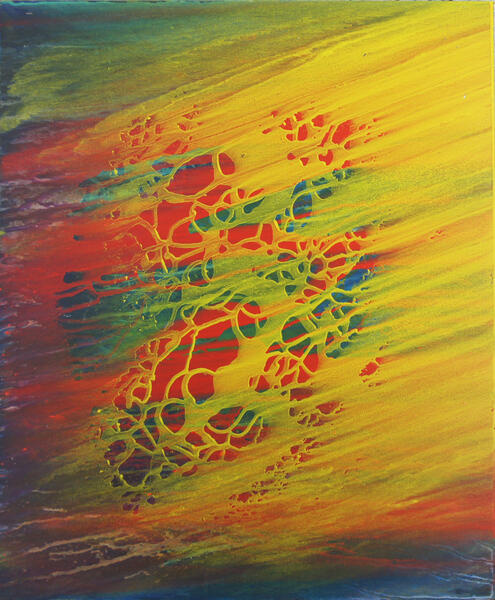 the total aim.jpgthe total aim 2016 acrylic on panel 24 by 18 inches
the total aim.jpgthe total aim 2016 acrylic on panel 24 by 18 inches -
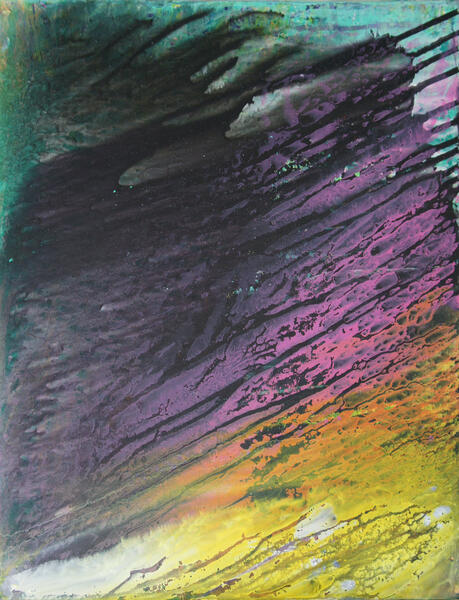 enough to substitute.jpgenough to substitue 2016 acrylic on panel 18 by 14 inches
enough to substitute.jpgenough to substitue 2016 acrylic on panel 18 by 14 inches -
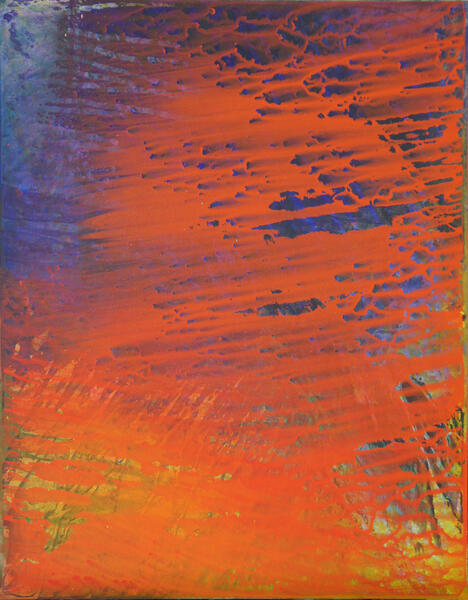 of moving masses.jpgof moving masses 2016 acrylic on panel 18 by 14 inches
of moving masses.jpgof moving masses 2016 acrylic on panel 18 by 14 inches -
 measurable forces.jpgmeasurable forces 2016 acrylic on panel 18 by 14 inches
measurable forces.jpgmeasurable forces 2016 acrylic on panel 18 by 14 inches -
 plastic invention"plastic invention" 40 by 60 inches acrylic on canvas 2017
plastic invention"plastic invention" 40 by 60 inches acrylic on canvas 2017 -
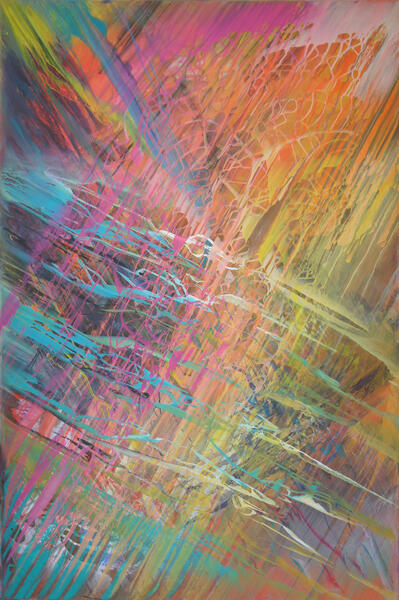 the analysis extended"the analysis extended" 60 by 40 inches acrylic on canvas 2017
the analysis extended"the analysis extended" 60 by 40 inches acrylic on canvas 2017 -
 the senses themselves"the senses themselves" 40 by 30 inches acrylic on canvas 2017
the senses themselves"the senses themselves" 40 by 30 inches acrylic on canvas 2017 -
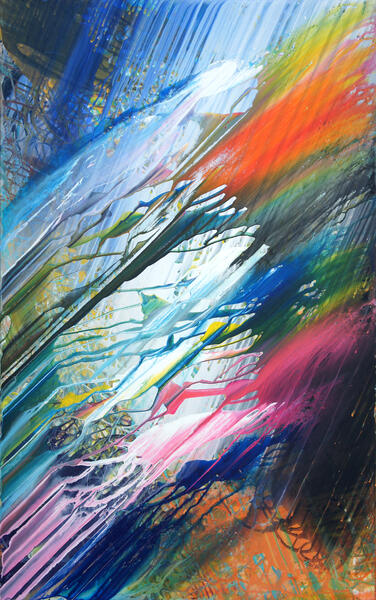 the very outset"the very outset" 54 by 34 inches acrylic on canvas 2017
the very outset"the very outset" 54 by 34 inches acrylic on canvas 2017 -
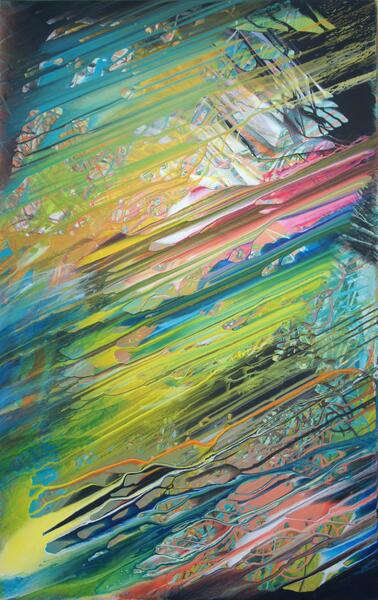 common positive end"common positive end" 54 by 34 inches acrylic on canvas 2017
common positive end"common positive end" 54 by 34 inches acrylic on canvas 2017 -
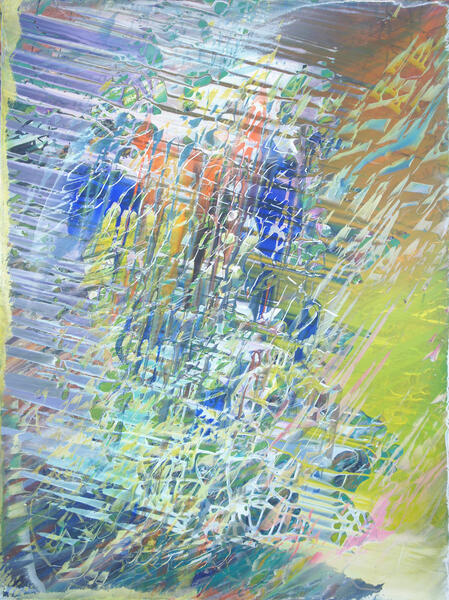 reality of the model"reality of the model" 40 by 30 inches acrylic on canvas 2017
reality of the model"reality of the model" 40 by 30 inches acrylic on canvas 2017
Selected Paintings, 2014-2015
2015 continued with an interest in the "white out" of the later works from 2014. More and more use of white occurred although my methods, composition, etc, began to flux a little. And, by mid-2015, color is gradually but dramatically re-introduced. In many ways, I think the white paintings from 2014 and early 2015 paved the way for the re-introduction of saturated color later in 2015--a forest fire to promote new growth, so to speak. Below is the full exhibition statement for the exhibition that showcased these paintings:
Exhibition Statement for "Wash: New Paintings by Greg Minah"
Water shapes things. It erodes and transplants; it pools and it dries away. It conspires with the ground to carve and bend and draw the landscape. “Wash: New Paintings by Greg Minah” showcases the co-authorial role that water has as an instrument in my artmaking.
My work has always been a collaboration between artist and material. Poured acrylic paint is manipulated not with a brush but by tilting, turning, and rotating the painting itself.* In her essay, “Paint Awash on a Shifting Ground,” retired director of the Baltimore Museum of Art Doreen Bolger writes:
"Despite the seeming spontaneity of Minah's work, there is incredible control, with the movement of his body in relation to the canvas determining the outcome. In an odd way, this action becomes the antithesis of Pollock's own painterly gestures, which directed the paint to a stationary ground before or below him. Pollock moved the pigment; Minah moves the ground."**
This process also involves the removal of partially dried layers of paint with pressurized water, leaving (usually) opaque remnants of paint applications. But the paintings presented here, all from 2015, while still physically manipulated to direct the behavior of the paint, have had water introduced, at times, more gradually and more broadly.
In these works, paint is often eased away--kindly coaxed by sheets of water. I’ve used larger applications of water to slowly and gently affect the material over longer periods of time. After the initial moves, the canvas might be propped up at an angle to allow these veils of water to pull and spread the paint over greater areas. The wash, encouraged but unhurried by gravity, works on the pigment methodically. Sweeping visual statements are written with subplots and footnotes intermixed. Rather than completely removing any evidence of the wash as I’ve done in earlier works, here, I’ve allowed the footprints to remain. As a result, the layers become more ethereal. Line, shape, and color freely exchange breath and brainstorm ideas until a kind of drone harmony takes form.
I consider these paintings to be sorts of landscapes, connoting the growth and decay of terrain sculpted by natural force. I’m a participant in these pieces, pivoting with the unpredictable nature of fluid paint. And at times I’m simply an observer, gazing at the material flux in the same way one gazes at the sea. A crashing wave disrupts the sand, scattering anything in its path. Then it soothes the sand as it draws away and washes things into place."
*To watch a short video highlighting this painting method, go to vimeo.com/33253072
** A link to the electronic version of the exhibition catalog “Greg Minah: Shifting Ground, Selected Paintings 2008-2014,” which includes the full essay, can be found on my website gregminah.com
-
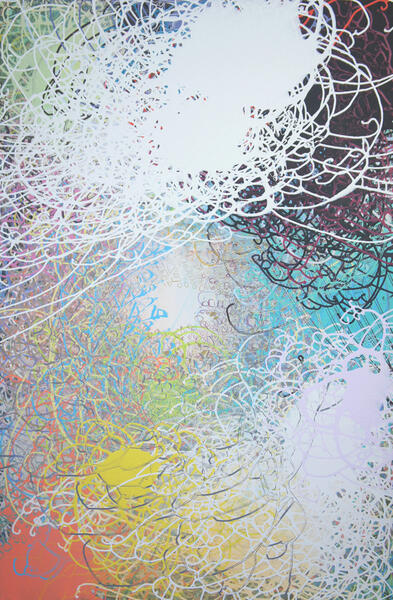 whatever the synthesis60 by 40 inches, acrylic on canvas, 2014
whatever the synthesis60 by 40 inches, acrylic on canvas, 2014 -
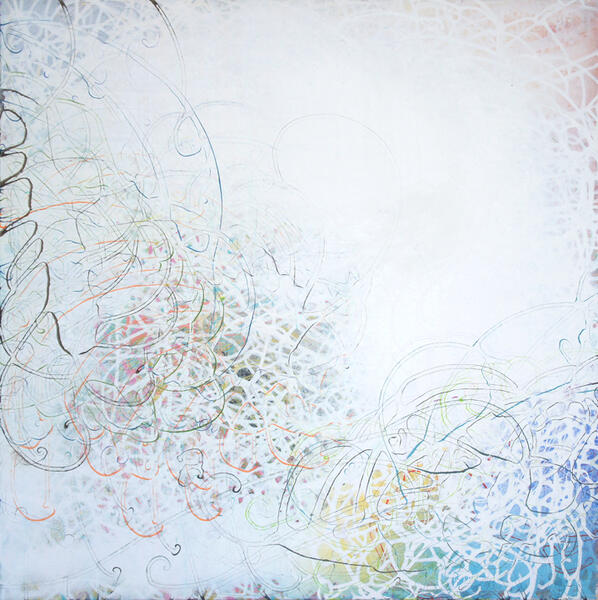 its own orientation30 by 30 inches, acrylic on canvas, 2015
its own orientation30 by 30 inches, acrylic on canvas, 2015 -
 these new preoccupations36 by 60 inches, acrylic on canvas, 2015
these new preoccupations36 by 60 inches, acrylic on canvas, 2015 -
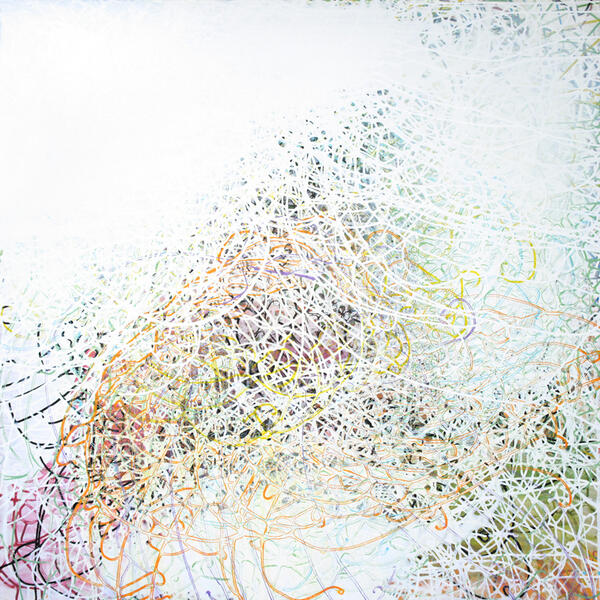 a continual procession48 by 48 inches, acrylic on canvas, 2015
a continual procession48 by 48 inches, acrylic on canvas, 2015 -
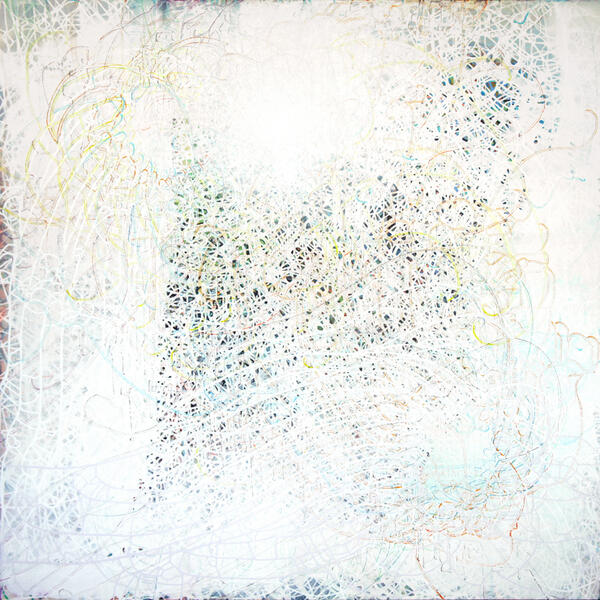 143-the-order-nature-lo-res-2.jpg
143-the-order-nature-lo-res-2.jpg -
 all objects participated18 by 18 inches, acrylic on canvas, 2015
all objects participated18 by 18 inches, acrylic on canvas, 2015 -
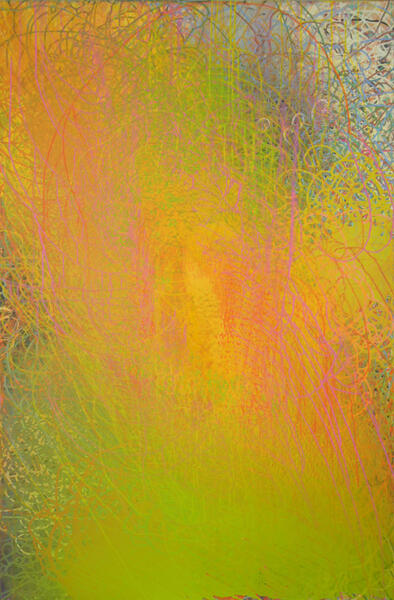 a common enveloping60 by 40 inches, acrylic on canvas, 2015
a common enveloping60 by 40 inches, acrylic on canvas, 2015 -
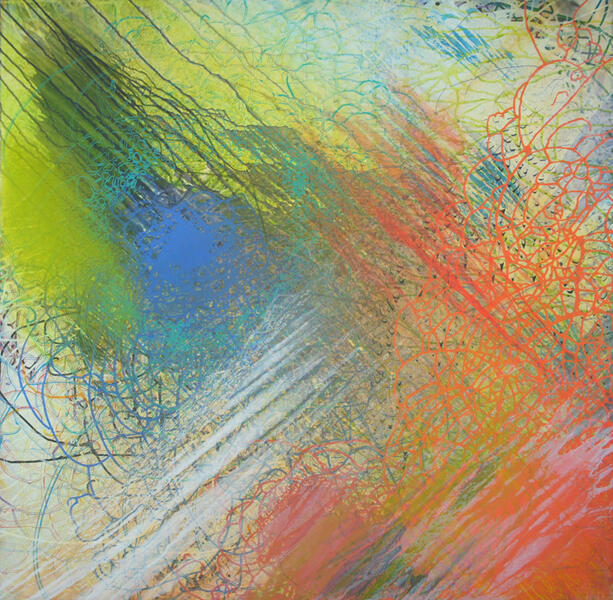 the identical phrase48 by 48 inches, acrylic on canvas, 2015
the identical phrase48 by 48 inches, acrylic on canvas, 2015 -
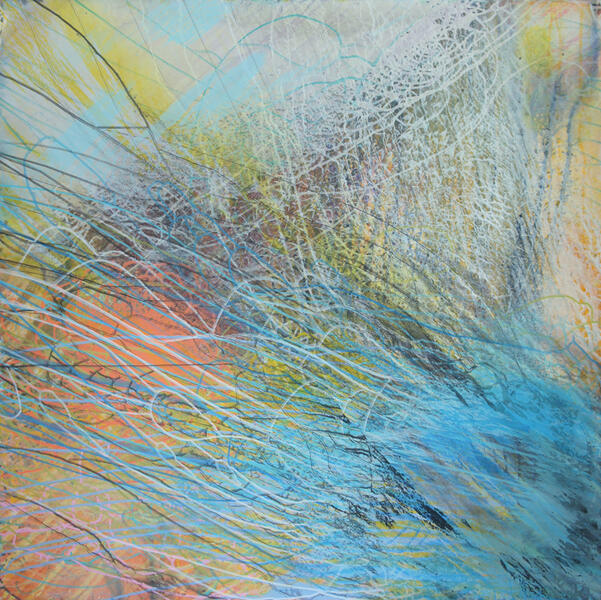 the tempo of moving masses48 by 48 inches, acrylic on canvas, 2015
the tempo of moving masses48 by 48 inches, acrylic on canvas, 2015 -
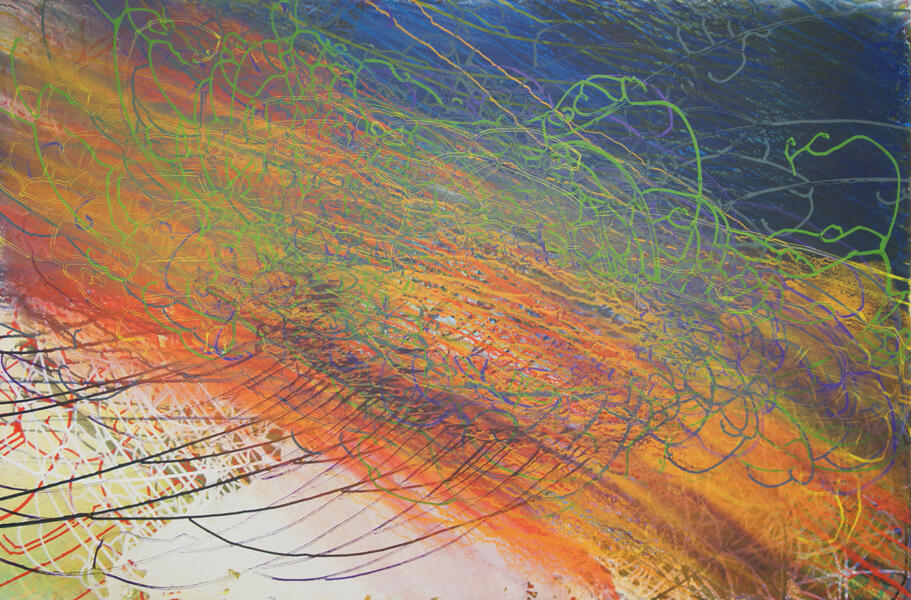 mood was present40 by 60 inches, acrylic on canvas, 2015
mood was present40 by 60 inches, acrylic on canvas, 2015
Selected Paintings, 2012-2013
The most obvious change in direction in 2013 was the use of the circular stretchers. This format has been in the back of my mind since developing this method of painting several years back. It just seemed to make sense to to experiment with this frame given the rolling, turning, spinning nature of my working process. The experience was very difficult as I realized that my curves and flowing, rhythmic lines had gotten used to having right angles to play off of. The circular paintings went through a lot of changes throughout their creation, resulting in a a new kind of depth that can come only with adding more and more layers.
I carried this development into the latest series of 60 by 40 inch stretchers. The edge is back but the added amount of layers of paint (most are quickly partially removed before trying completely to leave only the outline) are still there. This is why I've added a compilation of detail images that attempt to document the subtly and fine level of minuscule detail present in these most recent paintings.
-
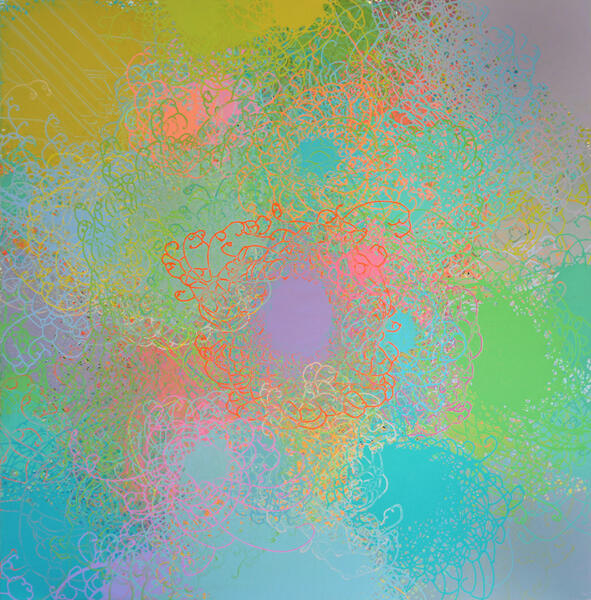 traditional factors70 by 70 inches, acrylic on canvas, 2012
traditional factors70 by 70 inches, acrylic on canvas, 2012 -
 plastic schemes42 by 42 inches, acrylic on canvas, 2012
plastic schemes42 by 42 inches, acrylic on canvas, 2012 -
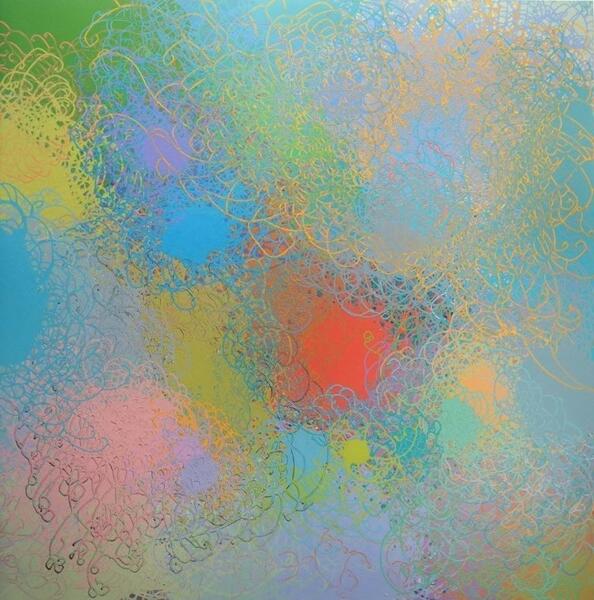 geographic notions70 by 70 inches, acrylic on canvas, 2012
geographic notions70 by 70 inches, acrylic on canvas, 2012 -
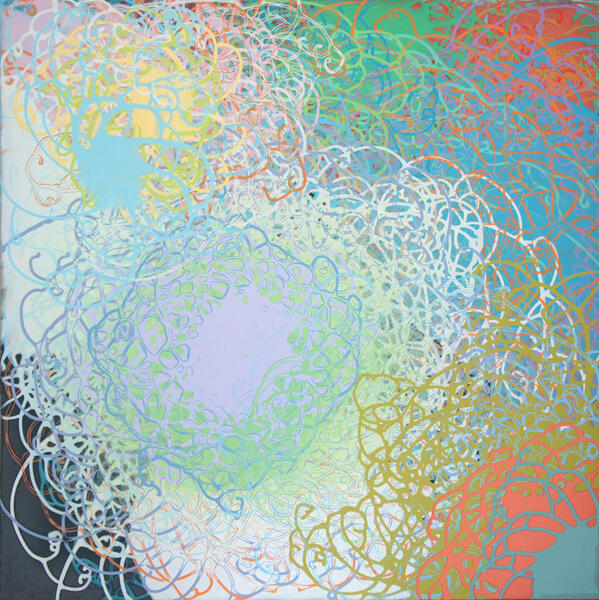 inventing a myth34 by 34 inches, acrylic on canvas, 2012
inventing a myth34 by 34 inches, acrylic on canvas, 2012 -
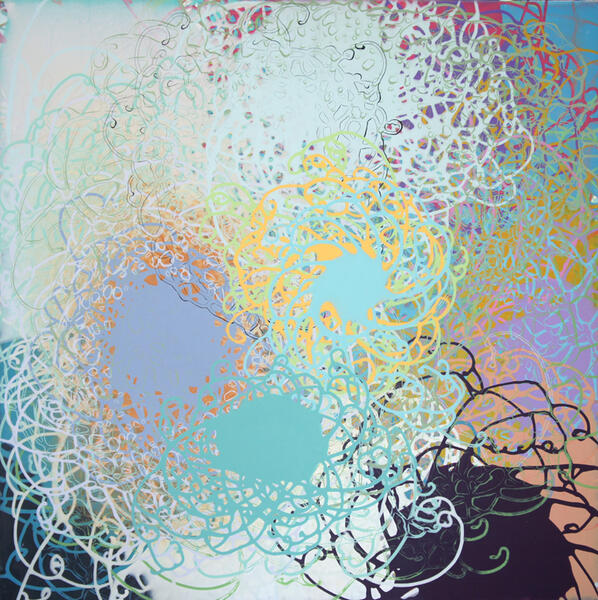 agency of light34 by 34 inches, acrylic on canvas, 2012
agency of light34 by 34 inches, acrylic on canvas, 2012 -
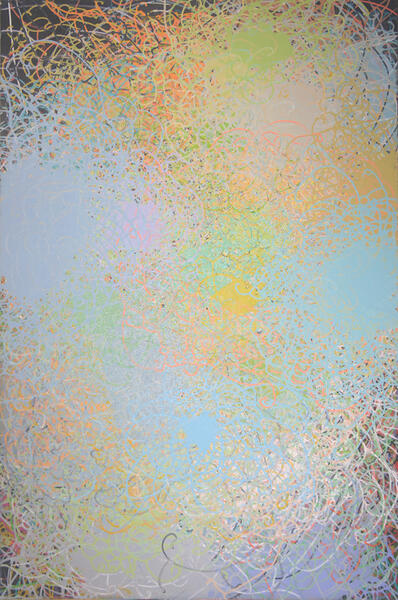 the materials described60 by 40 inches, acrylic on canvas, 2013
the materials described60 by 40 inches, acrylic on canvas, 2013 -
 seen as answerable60 by 40 inches, acrylic on canvas, 2013
seen as answerable60 by 40 inches, acrylic on canvas, 2013 -
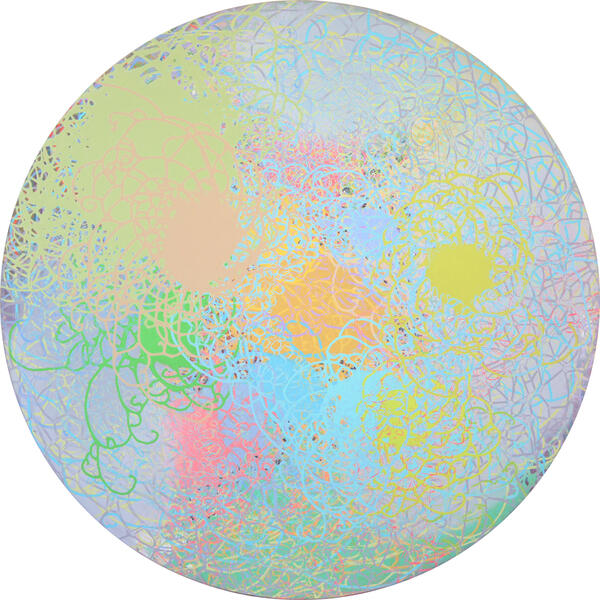 a basic difference42 inches (diameter), acrylic on canvas, 2013
a basic difference42 inches (diameter), acrylic on canvas, 2013 -
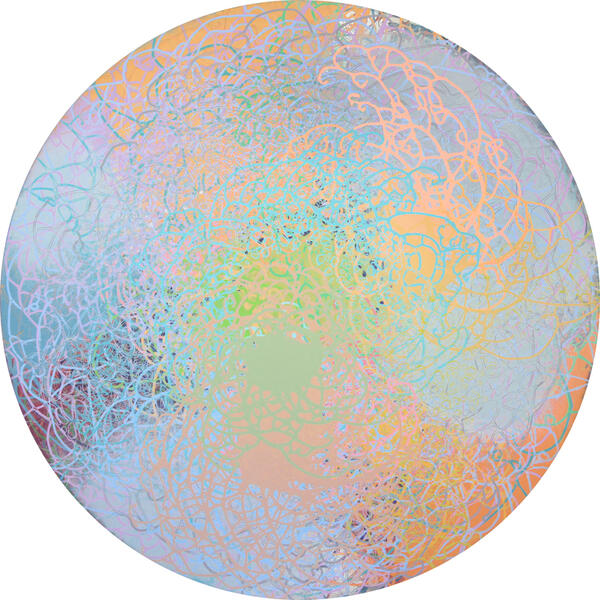 the sum total42 inches (diameter), acrylic on canvas, 2013
the sum total42 inches (diameter), acrylic on canvas, 2013 -
 2013 Detail ImagesMy most recent paintings have more applications of paint than previous series, so detail shots are becoming necessary to document the subtle nuance present upon closer inspection of these paintings.
2013 Detail ImagesMy most recent paintings have more applications of paint than previous series, so detail shots are becoming necessary to document the subtle nuance present upon closer inspection of these paintings.
Painting Process, 2011
I shot the video using my Sony NEX-3 camera, edited it using Sony Vegas Movie Studio HD, and I composed the music on an iPad by playing/arranging virtual instruments in Garage Band and sampling noises from the actual painting process.
I've also provided some video stills with further explanation of important steps in the painting process.
The painting that I'm working on in "Greg Minah: Painting | Method" is entitled "certain truths" and can be seen in the "Paintings, 2011" project of this nomination.
-
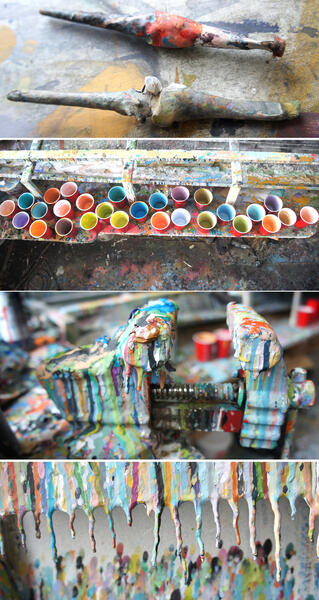 Misc Studio Shots, 2013A compilation of images taken around the studio this year. You might be able to track the growth of the "paint stalactites" in this image by comparing them to shots from the video shot in 2011.
Misc Studio Shots, 2013A compilation of images taken around the studio this year. You might be able to track the growth of the "paint stalactites" in this image by comparing them to shots from the video shot in 2011. -
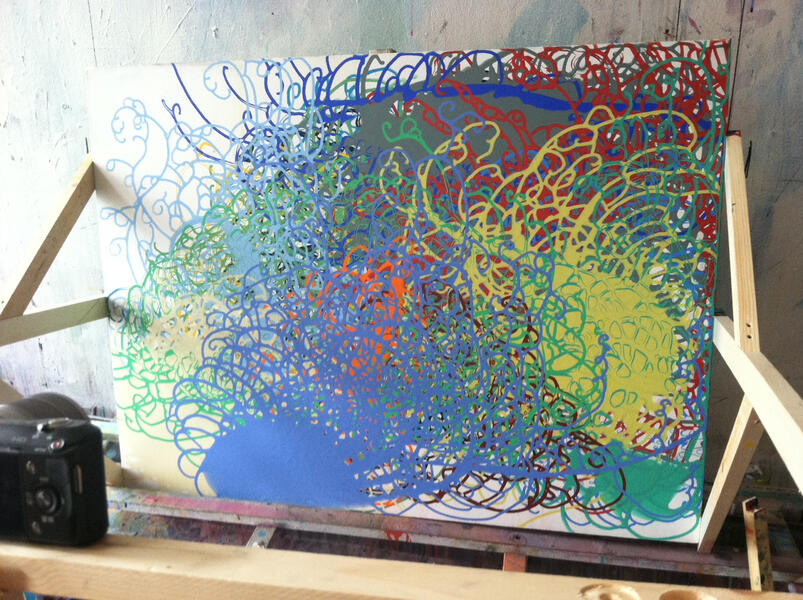 Camera MountThis is a picture of the camera attached the supports/mount I constructed to film "Greg Minah: Painting | Process." The camera was stationed roughly 3 feet from the surface, making the process of spinning the stretcher quite challenging.
Camera MountThis is a picture of the camera attached the supports/mount I constructed to film "Greg Minah: Painting | Process." The camera was stationed roughly 3 feet from the surface, making the process of spinning the stretcher quite challenging. -
Greg Minah: Painting | ProcessIn conjunction with an exhibit at Montgomery College (3Dx2D Squared: Themes and Variations of Organic Shape, 2011) I was asked to take part in a lecture at the school. In preparation for this, I decided to make some short videos that filmed the development of a pour with a camera fixed at a point so that the paint appears to be moving on its own. This then lead me to create a more stable support on a larger canvas so that I could document the creation of an entire painting from start to finish, which is what you see here in "Painting | Process." Since there were about 60 layers applied to this painting, the final video had to be sped up over 400X to get it to its current length. While many of the early layers are eventually hidden from view, they remain integral to the overall process since each step is a response to what came before.
-
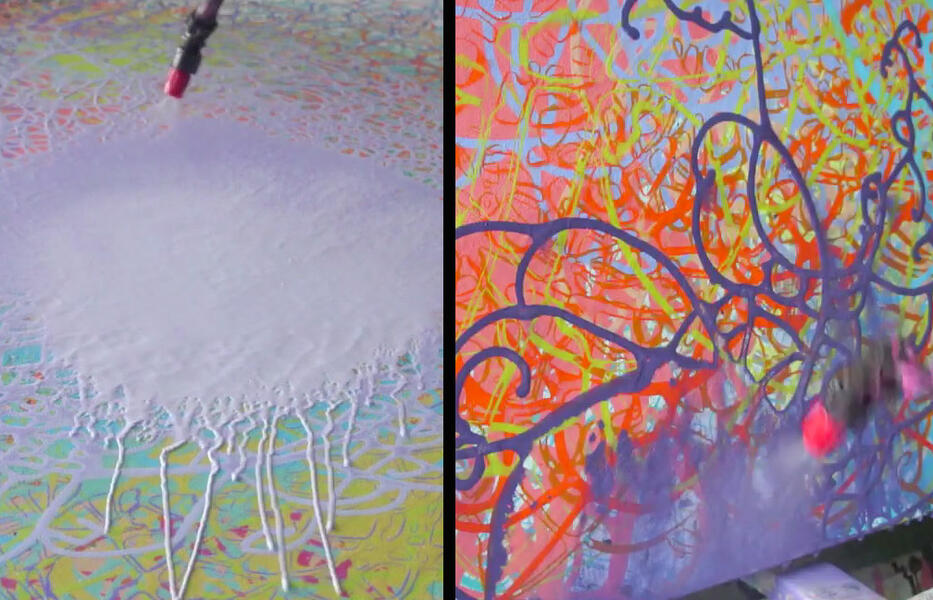 SprayingThis step might be my favorite as there's something very satisfying about washing away a layer of paint to reveal what lies beneath it. It feels, at times, like I am spraying the hidden layers back onto the canvas, rather than removing the top layer.
SprayingThis step might be my favorite as there's something very satisfying about washing away a layer of paint to reveal what lies beneath it. It feels, at times, like I am spraying the hidden layers back onto the canvas, rather than removing the top layer. -
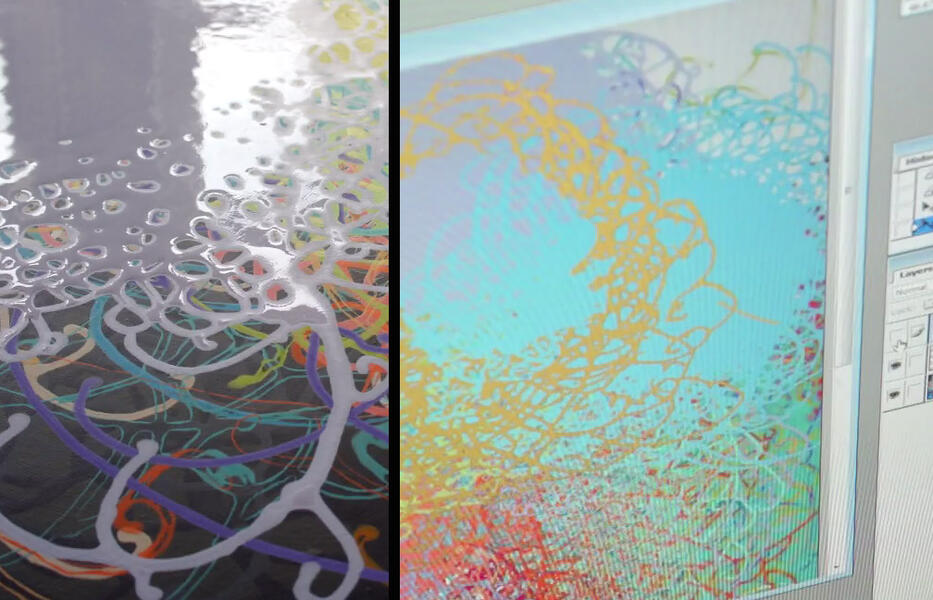 Layer RemovalPhotoshop comes into play again when I am deciding whether or not to remove a layer after it's applied. By taking a quick shot of the painting before I apply a layer of paint and then toggling between a solid layer and a layer where I've erased the middle, I can see what lies beneath the pour and decide whether I want to reveal this, or not, by removing the actual layer with water. This shot also shows how I keep track of how much a pour has dried. By allowing light from the window to reflect of the surface, I can see how thick or thin the outline of the pour will be when/if it is removed.
Layer RemovalPhotoshop comes into play again when I am deciding whether or not to remove a layer after it's applied. By taking a quick shot of the painting before I apply a layer of paint and then toggling between a solid layer and a layer where I've erased the middle, I can see what lies beneath the pour and decide whether I want to reveal this, or not, by removing the actual layer with water. This shot also shows how I keep track of how much a pour has dried. By allowing light from the window to reflect of the surface, I can see how thick or thin the outline of the pour will be when/if it is removed. -
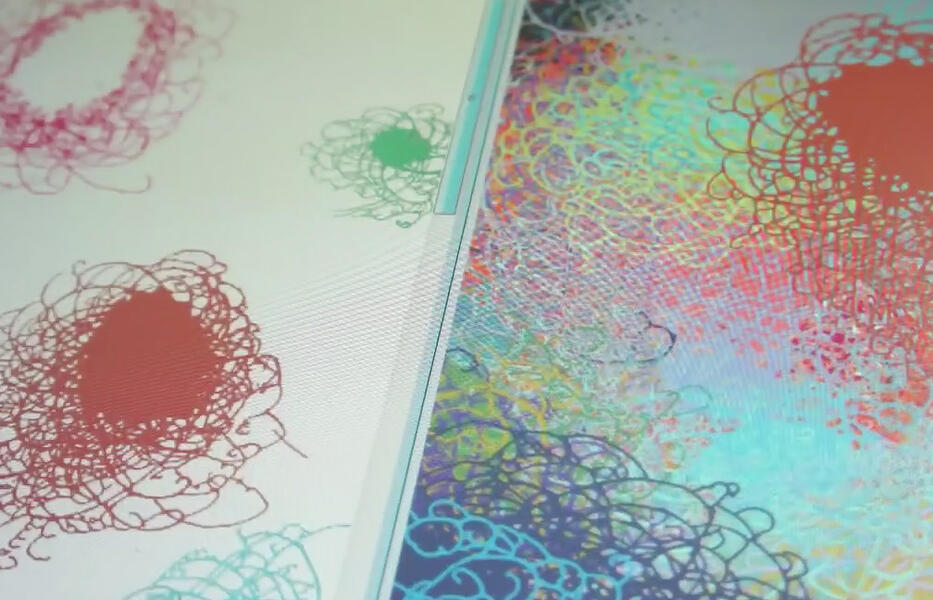 PhotoshopIn the beginning stages of a painting, decisions about color, shape, composition, etc., are more free and intuitive. But, as time goes on, these decisions become increasingly more difficult. As the painting nears completion, I spend a lot of time carefully planning out the next move. I can precisely control the color, placement, and shape of the pour in Photoshop as a sketch or guide before I do the actual application. On the left, you can see the file I have which contains dozens of different pour formations that I pull from and then manipulate to design the next step. Every aspect of the color--hue, saturation, lightness--can be fine tuned, as well.
PhotoshopIn the beginning stages of a painting, decisions about color, shape, composition, etc., are more free and intuitive. But, as time goes on, these decisions become increasingly more difficult. As the painting nears completion, I spend a lot of time carefully planning out the next move. I can precisely control the color, placement, and shape of the pour in Photoshop as a sketch or guide before I do the actual application. On the left, you can see the file I have which contains dozens of different pour formations that I pull from and then manipulate to design the next step. Every aspect of the color--hue, saturation, lightness--can be fine tuned, as well. -
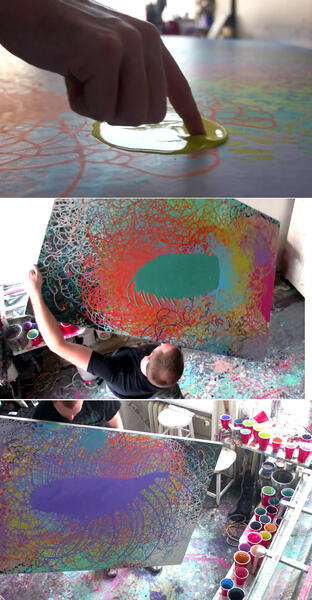 Pour and SpinPOUR After the paint is poured, it takes a lot of jiggling and shaping (sometimes by hand, as shown here) to get it in the right shape before I pick up the stretcher and begin manipulating the canvas. The overall shape of the final application depends on how this initial pour is formed. INITIAL SPIN At first, decisions and reactions must be made very quickly since the paint moves very fast in the beginning. SLOW SPIN As the paint disperses across the surface, it moves more and more slowly. This is when I'm able to precisely control where and how the final curves, shapes, etc will form.
Pour and SpinPOUR After the paint is poured, it takes a lot of jiggling and shaping (sometimes by hand, as shown here) to get it in the right shape before I pick up the stretcher and begin manipulating the canvas. The overall shape of the final application depends on how this initial pour is formed. INITIAL SPIN At first, decisions and reactions must be made very quickly since the paint moves very fast in the beginning. SLOW SPIN As the paint disperses across the surface, it moves more and more slowly. This is when I'm able to precisely control where and how the final curves, shapes, etc will form. -
 Drip TestThis canvas is installed on the wall next to my painting table so that I can test the fluidity of the paint as I'm mixing. I can tell a lot about how the paint will behave by how it drips down this canvas and it takes a lot of tweaking to get it just right.
Drip TestThis canvas is installed on the wall next to my painting table so that I can test the fluidity of the paint as I'm mixing. I can tell a lot about how the paint will behave by how it drips down this canvas and it takes a lot of tweaking to get it just right. -
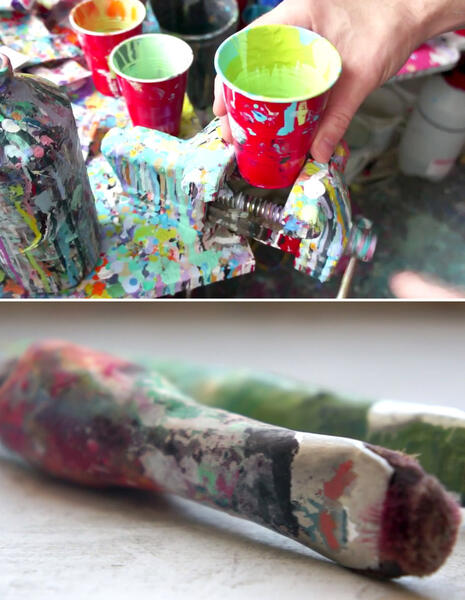 Mixing MethodsVISE I use this vise clamp to hold the mixing cups since I need both hands free to prepare the paint. I stir and break down the paint with one hand as I gradually add water, acrylic medium, gloss medium, other thinned paint, etc with the other. BRUSHES I use these brushes to mix the paint. The constant stirring has almost completely worn away the bristles and has reshaped the ferrule, as well. Over time, the paint accumulates on the handle, forming that large bulge.
Mixing MethodsVISE I use this vise clamp to hold the mixing cups since I need both hands free to prepare the paint. I stir and break down the paint with one hand as I gradually add water, acrylic medium, gloss medium, other thinned paint, etc with the other. BRUSHES I use these brushes to mix the paint. The constant stirring has almost completely worn away the bristles and has reshaped the ferrule, as well. Over time, the paint accumulates on the handle, forming that large bulge. -
Greg Minah: Painting | MethodI shot and produced this short video for the Baker Awards so that the viewer might have a fuller experience of my paintings and all that goes into their creation. Every step in the process is a chance for me to learn something new about how the paint behaves and each finished painting is the result of these steps working together gradually.
Selected Paintings, 2010-2011
Then, in the paintings from the later part of 2010, things begin to lighten up again. Colors are used sparingly and seem to say more. I also started to experiment with pouring thinned paint onto an already wet canvas, creating that glazing mask effect.
In 2011, because some of these paintings were so large, I had to construct a handle that attached to the back of the stretcher and spanned across the face so that I could see the paint as I moved the painting. The colors shift yet again and I sometimes wonder just how much the seasons might be affecting them.
-
 a plastic skepticism70 by 54 inches, acrylic on canvas, 2011
a plastic skepticism70 by 54 inches, acrylic on canvas, 2011 -
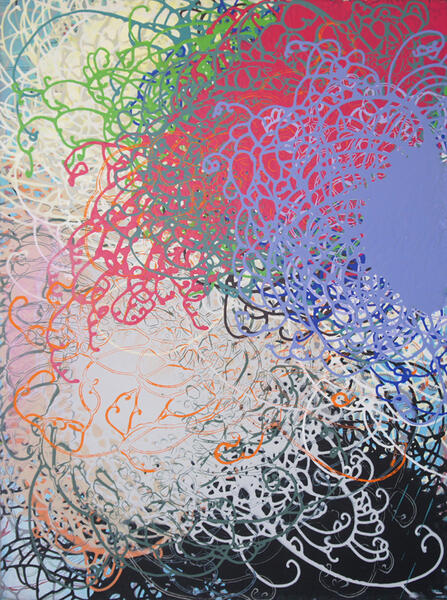 as to reality40 by 30 inches, acrylic on canvas, 2011
as to reality40 by 30 inches, acrylic on canvas, 2011 -
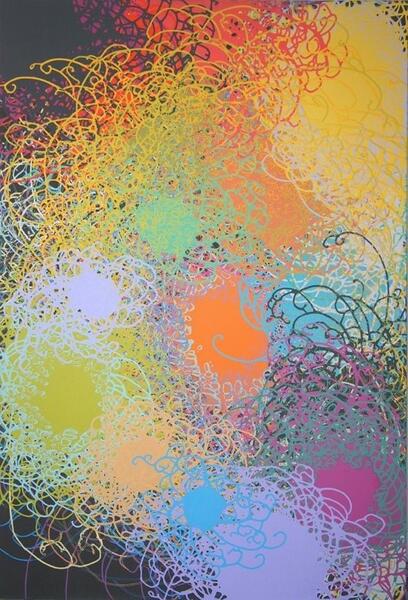 the exact limits62 by 42 inches, acrylic on canvas, 2011
the exact limits62 by 42 inches, acrylic on canvas, 2011 -
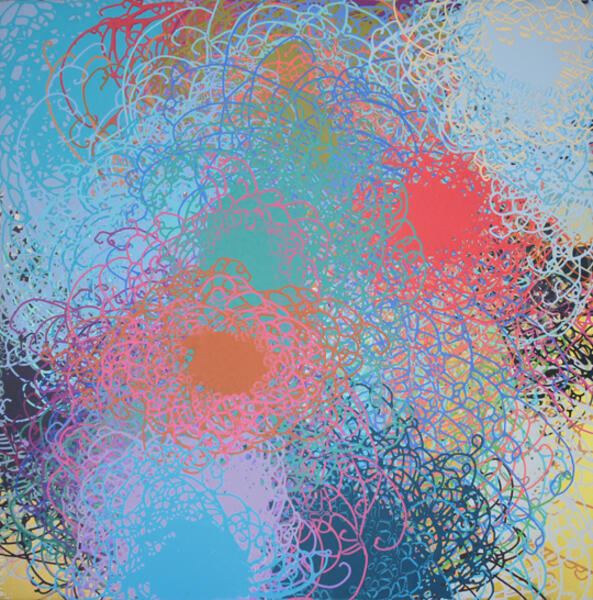 the scaffolding to remain54 by 54 inches, acrylic on canvas, 2011
the scaffolding to remain54 by 54 inches, acrylic on canvas, 2011 -
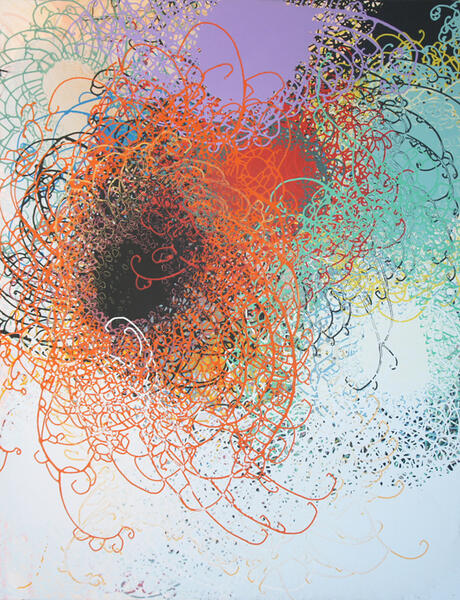 those great times70 by 54 inches, acrylic on canvas, 2011
those great times70 by 54 inches, acrylic on canvas, 2011 -
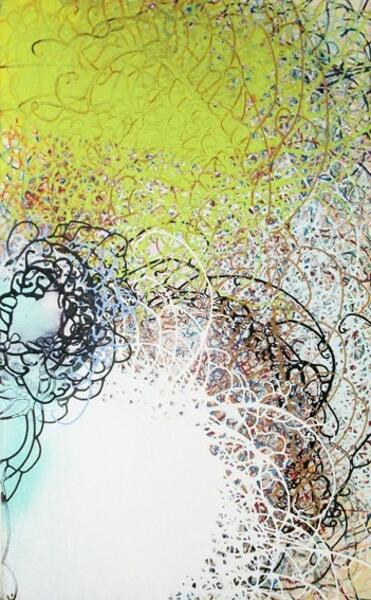 one for ourselves54 by 34 inches, acrylic on canvas, 2010
one for ourselves54 by 34 inches, acrylic on canvas, 2010 -
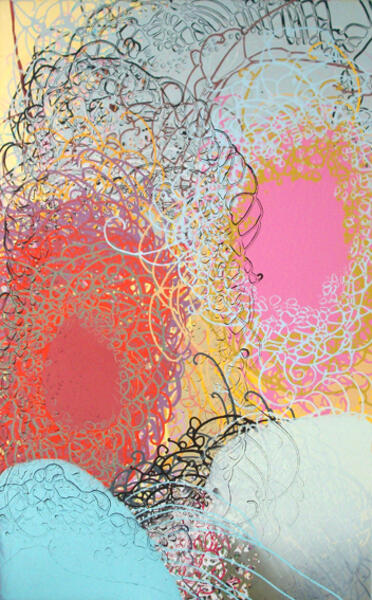 the succession of steps54 by 34 inches, acrylic on canvas, 2010
the succession of steps54 by 34 inches, acrylic on canvas, 2010 -
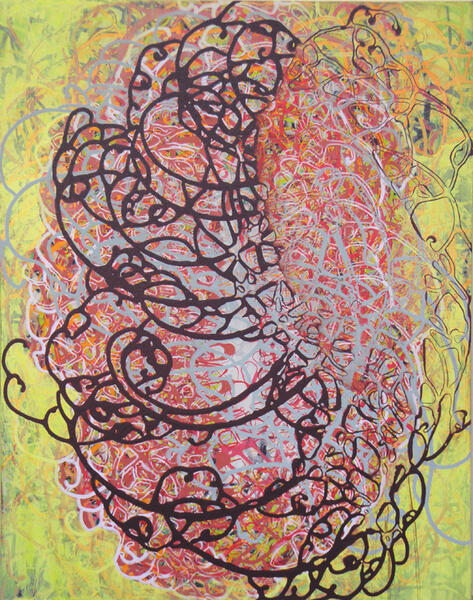 58-it-takes-place-lo-res-4.jpg
58-it-takes-place-lo-res-4.jpg -
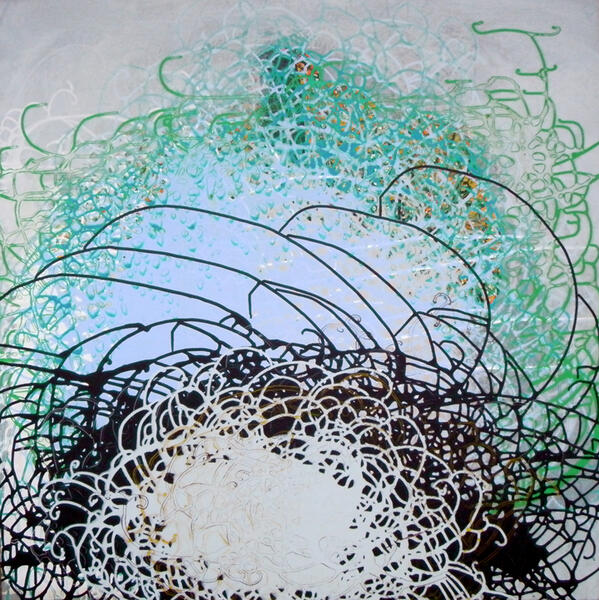 72-to-their-traditions-lo-res-4.jpg
72-to-their-traditions-lo-res-4.jpg -
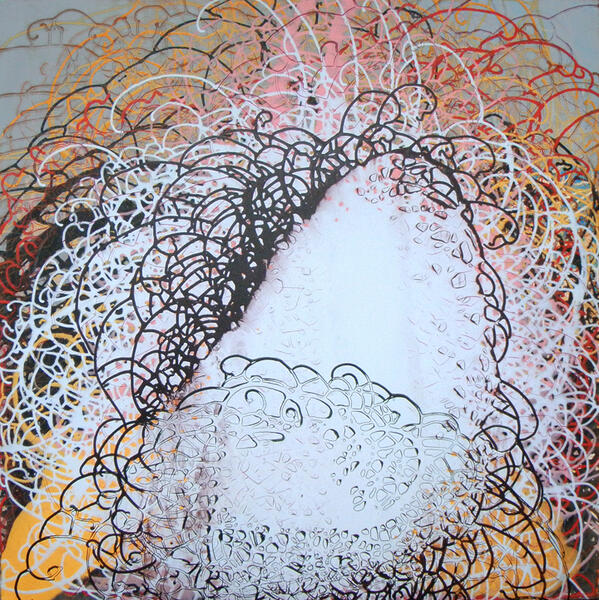 71-almost-axiomatic-lo-res-4.jpg
71-almost-axiomatic-lo-res-4.jpg
Selected Paintings, 2008-2009
These paintings, half of which were made during the Joshua Tree Artist Residency in 2008, mark a real turning point in my work. The light, landscape and isolation of the high desert had a profound impact on me and my work. This was also when I first began to experiment with dripping and pouring paint. UPDATE: I'll be returning to Joshua Tree for another residency in April, 2018! Excited to see how the desert treats me 10 years later!!
In 2009, you can trace the gradually decreasing role that the paint brush played in creating the work. The larger paintings were made by pouring and then masking layers with a brush. The smaller, square paintings were made with very little brushwork, relying more on applying more layers to achieve depth and atmosphere.
-
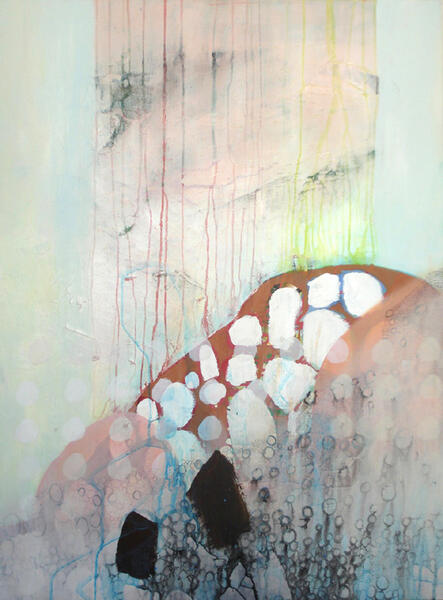 a sympathetic light40 by 30 inches, acrylic on canvas, 2008
a sympathetic light40 by 30 inches, acrylic on canvas, 2008 -
 this struggle36 by 36 inches, acrylic on canvas, 2008
this struggle36 by 36 inches, acrylic on canvas, 2008 -
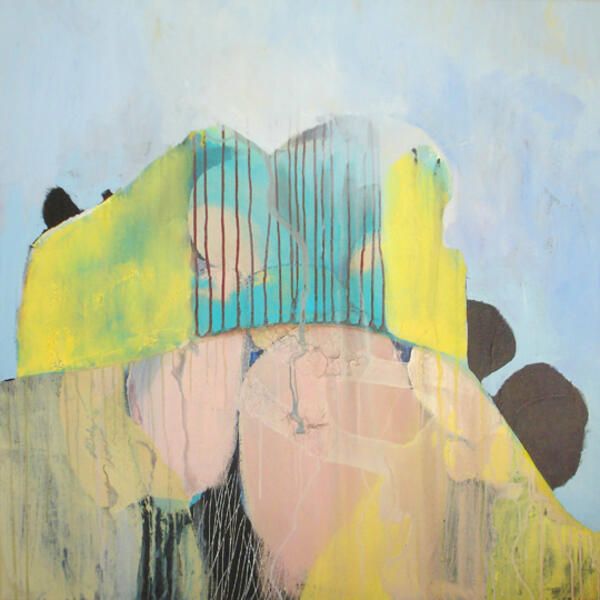 the preceding stage36 by 36 inches, acrylic on canvas, 2008
the preceding stage36 by 36 inches, acrylic on canvas, 2008 -
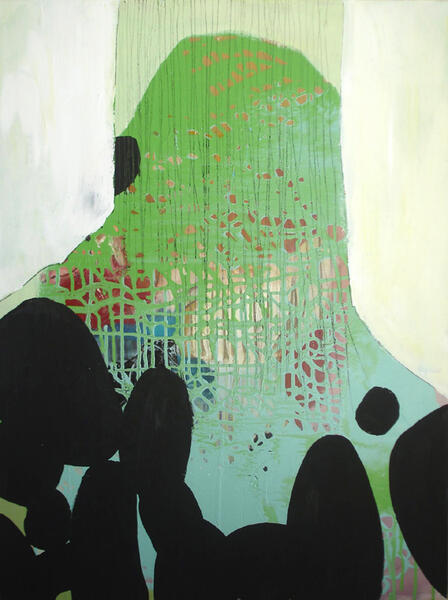 similar prejudices40 by 30 inches, acrylic on canvas, 2008
similar prejudices40 by 30 inches, acrylic on canvas, 2008 -
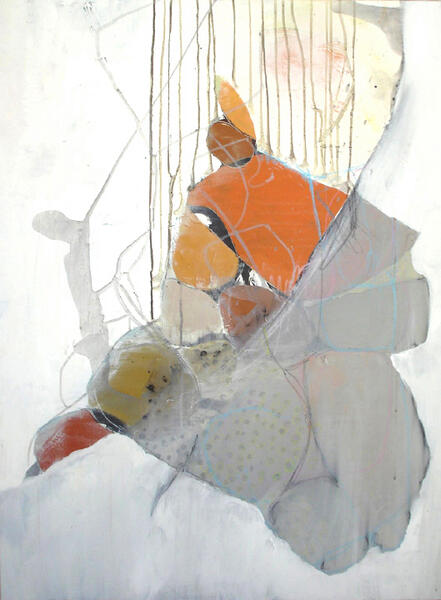 accumulations of centuries40 by 30 inches, acrylic on canvas
accumulations of centuries40 by 30 inches, acrylic on canvas -
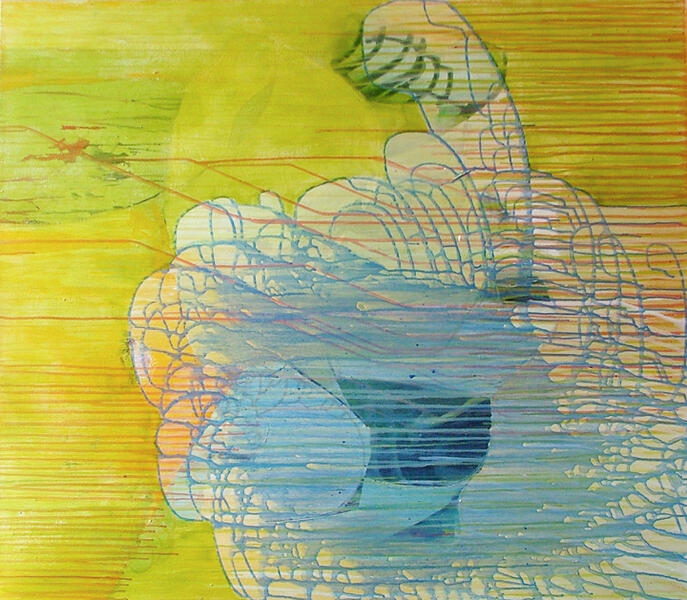 Since the time of Giotto42 by 48 inches, acrylic on canvas, 2008
Since the time of Giotto42 by 48 inches, acrylic on canvas, 2008 -
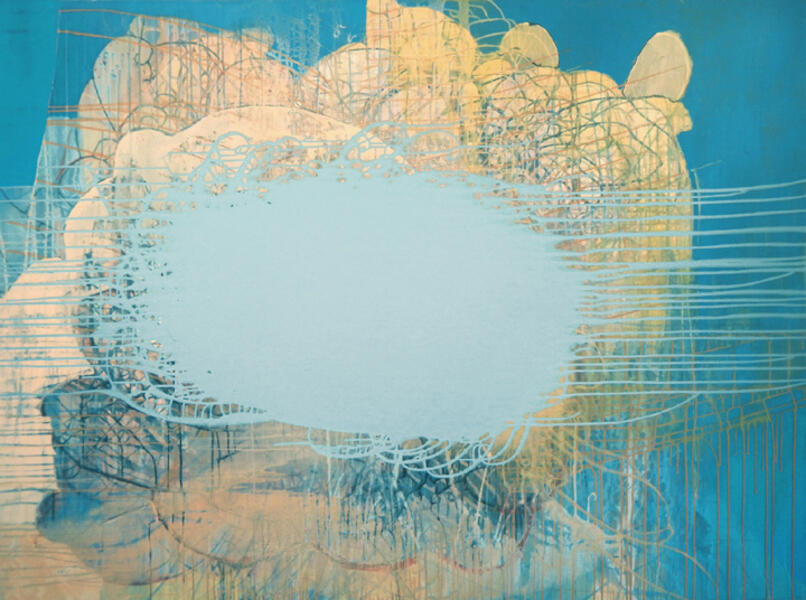 to shift the ends54 by 70 inches, acrylic on canvas, 2009
to shift the ends54 by 70 inches, acrylic on canvas, 2009 -
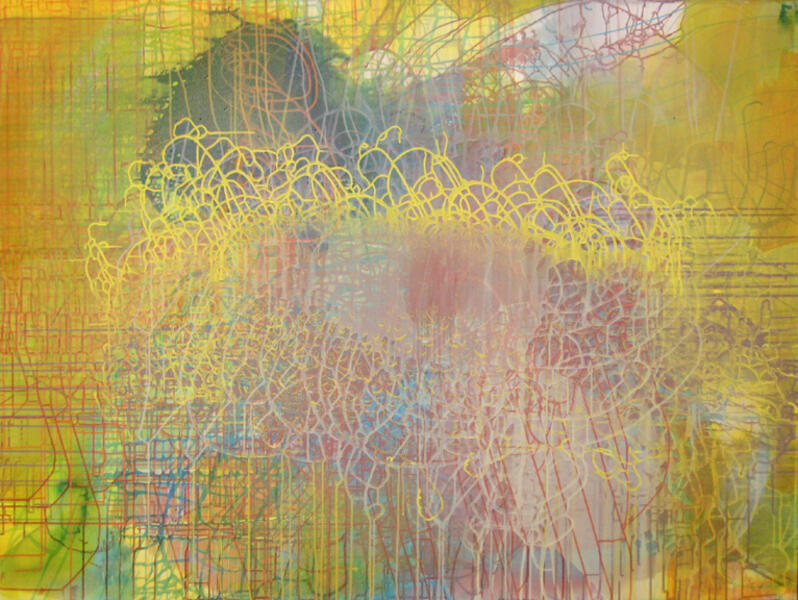 known sensationsknown sensations 54 by 72 inches, acrylic on canvas, 2009
known sensationsknown sensations 54 by 72 inches, acrylic on canvas, 2009 -
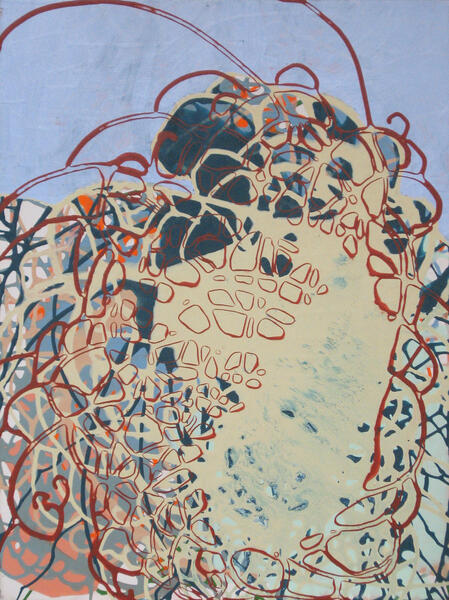 greater certainty24 by 18 inches, acrylic on canvas, 2009
greater certainty24 by 18 inches, acrylic on canvas, 2009 -
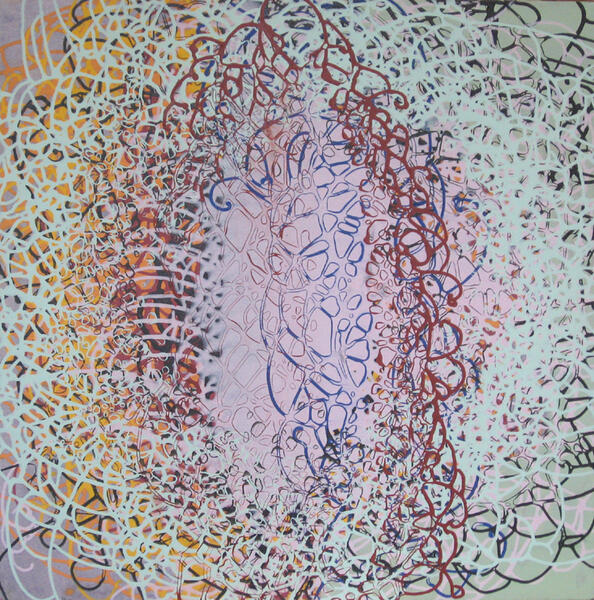 between pragmatism32 by 32 inches, acrylic on canvas, 2009
between pragmatism32 by 32 inches, acrylic on canvas, 2009
